Paul van Yperen's Blog, page 385
April 16, 2015
Derrick De Marney
Derrick De Marney (1906–1978) was a handsome and versatile English stage and film actor. Today, he is best known for his starring role as Robert Tisdall, wrongly accused of murder in Alfred Hitchcock's Young and Innocent (1937).
British postcard in the Picturegoer Series, no. 1193. Photo: Gaumont British.
British handcoloured postcard in the Film Partners Series, no. PC 236. Photo: Gaumont British. Publicity still for Young and Innocent/The Girl Was Young (Alfred Hitchcock, 1937) with Nova Pilbeam .
Hitchcock
Derrick De Marney was born in London, England, in 1906. He was the son of Violet Eileen Concanen and Arthur De Marney, and the grandson of noted Victorian lithographer Alfred Concanen.
Derrick appeared in repertory theatre from 1922 and hit the London stage four years later. In 1928, he made his film debut in the silent comedy Two Little Drummer Boys (G.B. Samuelson, 1928), co-starring with Georgie Wood and Alma Taylor . His debut was followed by roles in silent films like The Forger (G.B. Samuelson, 1928) starring Nigel Barrie and based on a novel Edgar Wallace.
His performance of ‘Young Mr Disraeli’ at the Kingsway and Piccadilly theatres brought him an offer of a long term film contract from Alexander Korda. For Korda’s Denham Studios, he appeared in the adventure film The Scarlet Pimpernel (Harold Young, 1934) starring Leslie Howard as the effete aristocrat who leads a double life, and the Science Fiction film Things to Come (William Cameron Menzies, 1936).
De Marney is perhaps best known for his starring role as Robert Tisdall, wrongly accused of murder in Alfred Hitchcock's Young and Innocent/The Girl Was Young (1937) with Nova Pilbeam . After Young and Innocent, he alternated between leading roles and supporting parts in films.
Other early film roles include Benjamin Disraeli (the role he had played on stage in Young Mr. Disraeli) in the successful historical film Victoria the Great (Herbert Wilcox, 1937), and its sequel, Sixty Glorious Years (Herbert Wilcox, 1938), both starring Anna Neagle as Queen Victoria.
British postcard.
British postcard.
British postcard.
The Gentle Sex
In 1941, Derrick de Marney formed with his brother, the actor Terence De Marney, Concanen Productions (named for their mother). They produced a number of wartime documentaries on the Polish Air Force, including The White Eagle (1942) and Diary of a Polish Airman (Eugeniusz Cekalski, 1942), as well as Leslie Howard 's feature film The Gentle Sex (1943).
The Gentle Sex tells about the experiences of seven new recruits (played by a.o. Joan Greenwood, Rosamund John and Lili Palmer ) to the Auxiliary Territorial Service (ATS) as they undergo basic training and receive their first assignments. Derrick himself directed the documentary shorts Malta G.C. (1942) and London Scrapbook (1942).
After the war, he played memorable title role in Uncle Silas/The Inheritance (Charles Frank, 1947), based on the Victorian Gothic mystery-thriller novel by the Irish writer J. Sheridan Le Fanu. De Marney played a sinister old fortune hunter plotting against a young woman played by Jean Simmons .
De Marney also produced and starred in the thrillers Latin Quarter (Vernon Sewell, 1945), No Way Back (Stefan Osiecki, 1949), which he also wrote, and which starred his brother Terence, She Shall Have Murder (Daniel Birt, 1950) featuring Rosamund John , and Meet Mr. Callaghan (Charles Saunders, 1954) starring as Peter Cheyney's hard-boiled detective Slim Callaghan, a role he had created on stage in 1952.
Later, he tended to concentrate on the theatre, only taking small roles in film and television. He continued to maintain diverse interests, De Marney even promoted a troupe of Javanese dancers he brought to Britain in the 1940s and 1950s.
His last role was in the horror film The Projected Man (Ian Curteis, 1966) starring Mary Peach. Derrick De Marney had a home in Kensington in London, but he was taken ill while staying with friends at Farnham in Surrey. He died of bronchopneumonia and asthma at the nearby Frimley Park Hospital in 1978. He was 71.
British postcard.
British postcard.
British postcard.
Scene from Young and Innocent/The Girl Was Young (Alfred Hitchcock, 1937). Source: brukkala's channel (YouTube).
Source: (IMDb), Brian McFarlane (Encyclopedia of British Film), Hal Erickson (AllMovie), BritMovie, Wikipedia and .
British postcard in the Picturegoer Series, no. 1193. Photo: Gaumont British.
British handcoloured postcard in the Film Partners Series, no. PC 236. Photo: Gaumont British. Publicity still for Young and Innocent/The Girl Was Young (Alfred Hitchcock, 1937) with Nova Pilbeam .
Hitchcock
Derrick De Marney was born in London, England, in 1906. He was the son of Violet Eileen Concanen and Arthur De Marney, and the grandson of noted Victorian lithographer Alfred Concanen.
Derrick appeared in repertory theatre from 1922 and hit the London stage four years later. In 1928, he made his film debut in the silent comedy Two Little Drummer Boys (G.B. Samuelson, 1928), co-starring with Georgie Wood and Alma Taylor . His debut was followed by roles in silent films like The Forger (G.B. Samuelson, 1928) starring Nigel Barrie and based on a novel Edgar Wallace.
His performance of ‘Young Mr Disraeli’ at the Kingsway and Piccadilly theatres brought him an offer of a long term film contract from Alexander Korda. For Korda’s Denham Studios, he appeared in the adventure film The Scarlet Pimpernel (Harold Young, 1934) starring Leslie Howard as the effete aristocrat who leads a double life, and the Science Fiction film Things to Come (William Cameron Menzies, 1936).
De Marney is perhaps best known for his starring role as Robert Tisdall, wrongly accused of murder in Alfred Hitchcock's Young and Innocent/The Girl Was Young (1937) with Nova Pilbeam . After Young and Innocent, he alternated between leading roles and supporting parts in films.
Other early film roles include Benjamin Disraeli (the role he had played on stage in Young Mr. Disraeli) in the successful historical film Victoria the Great (Herbert Wilcox, 1937), and its sequel, Sixty Glorious Years (Herbert Wilcox, 1938), both starring Anna Neagle as Queen Victoria.
British postcard.
British postcard.
British postcard.
The Gentle Sex
In 1941, Derrick de Marney formed with his brother, the actor Terence De Marney, Concanen Productions (named for their mother). They produced a number of wartime documentaries on the Polish Air Force, including The White Eagle (1942) and Diary of a Polish Airman (Eugeniusz Cekalski, 1942), as well as Leslie Howard 's feature film The Gentle Sex (1943).
The Gentle Sex tells about the experiences of seven new recruits (played by a.o. Joan Greenwood, Rosamund John and Lili Palmer ) to the Auxiliary Territorial Service (ATS) as they undergo basic training and receive their first assignments. Derrick himself directed the documentary shorts Malta G.C. (1942) and London Scrapbook (1942).
After the war, he played memorable title role in Uncle Silas/The Inheritance (Charles Frank, 1947), based on the Victorian Gothic mystery-thriller novel by the Irish writer J. Sheridan Le Fanu. De Marney played a sinister old fortune hunter plotting against a young woman played by Jean Simmons .
De Marney also produced and starred in the thrillers Latin Quarter (Vernon Sewell, 1945), No Way Back (Stefan Osiecki, 1949), which he also wrote, and which starred his brother Terence, She Shall Have Murder (Daniel Birt, 1950) featuring Rosamund John , and Meet Mr. Callaghan (Charles Saunders, 1954) starring as Peter Cheyney's hard-boiled detective Slim Callaghan, a role he had created on stage in 1952.
Later, he tended to concentrate on the theatre, only taking small roles in film and television. He continued to maintain diverse interests, De Marney even promoted a troupe of Javanese dancers he brought to Britain in the 1940s and 1950s.
His last role was in the horror film The Projected Man (Ian Curteis, 1966) starring Mary Peach. Derrick De Marney had a home in Kensington in London, but he was taken ill while staying with friends at Farnham in Surrey. He died of bronchopneumonia and asthma at the nearby Frimley Park Hospital in 1978. He was 71.
British postcard.
British postcard.
British postcard.
Scene from Young and Innocent/The Girl Was Young (Alfred Hitchcock, 1937). Source: brukkala's channel (YouTube).
Source: (IMDb), Brian McFarlane (Encyclopedia of British Film), Hal Erickson (AllMovie), BritMovie, Wikipedia and .
Published on April 16, 2015 22:00
April 15, 2015
Greetings from Utrecht, Part 2
Last weekend we visited the International Collectors Fair in Utrecht. It was fun! In three posts we share our new acquisitions. Today, part 2.
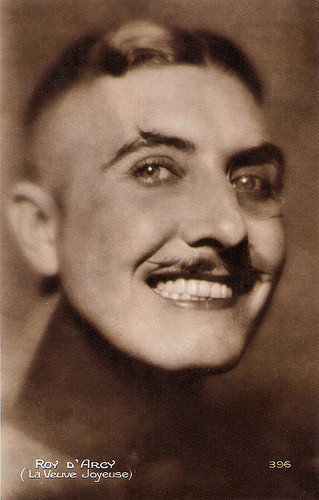
French postcard by Cinémagazine-Edition, Paris, no. 396. Photo: publicity still for The Merry Widow (Erich Von Stroheim, 1925).
American character actor Roy d'Arcy (1894-1969) played his most famous role as the villainous, arrogant Prince Mirko in Erich Von Stroheim’s classic The Merry Widow (1925), starring Mae Murray and John Gilbert. Because of the success of that film, D'Arcy was thrown into several other productions as the head villain, but also in several comedies.
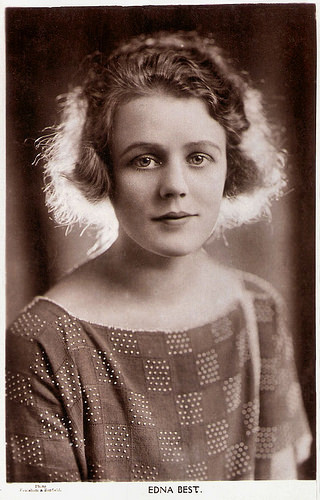
British postcard in the Picturegoer Series, London, no. 71. Photo: Foulsham & Banfield.
British actress Edna Best (1900–1974) was known on the London stage before she entered films in 1921. She is best remembered for her role as the mother in the original 1934 film version of Alfred Hitchcock's The Man Who Knew Too Much. Among her other film credits are Intermezzo: A Love Story (1939), Swiss Family Robinson (1940), The Ghost and Mrs. Muir (1947) and The Iron Curtain (1948).
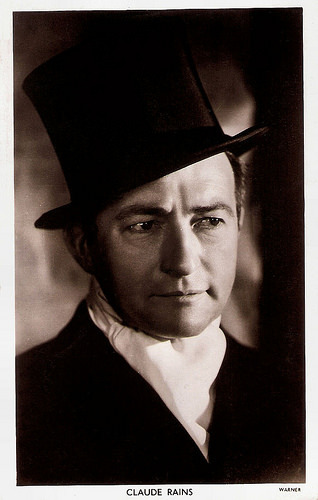
British postcard by the Picturegoer Series, London, no. B.8. Photo: Warner.
The career of English stage and film actor Claude Rains (1889-1967) spanned 47 years. In Hollywood he was a supporting actor who achieved A-list stardom. With his smooth distinguished voice he could portray a wide variety of roles, ranging from villains to sympathetic gentlemen. He is best known as the title figure in The Invisible Man (1933), as wicked Prince John in The Adventures of Robin Hood (1938), as a corrupt senator in Mr. Smith Goes to Washington (1939), and, of course, as Captain Renault in Casablanca (1942).
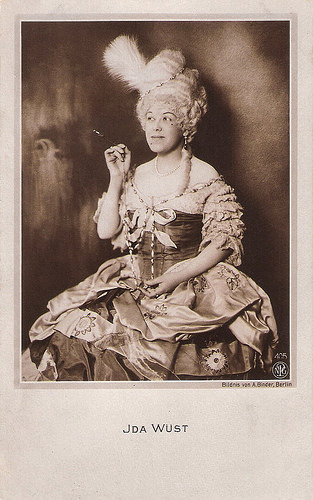
German postcard by NPG, no. 405. Photo: Alex Binder, Berlin.
German actress Ida Wüst (1884-1956) was a popular Ufa star in the 1920s and 1930s. She appeared in almost 150 films.
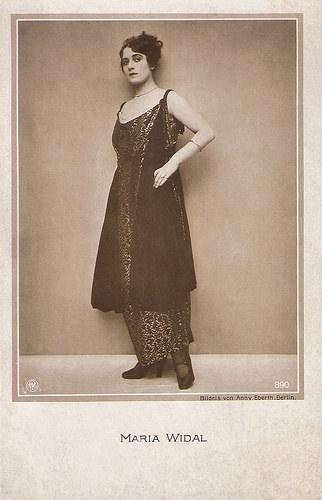
German postcard by NPG, no. 890. Photo: Anny Eberth, Berlin.
Between 1914 and 1922, actress Maria Widal played in the European silent cinema. She started her career as Luzzy Werne (or Werren) in 18 Danish films. From 1916 on, she appeared in the German cinema, where most of her films were directed by Urban Gad.
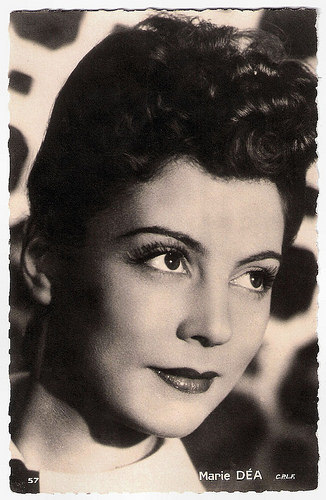
French postcard by Ed. Chantal, Rueil, Paris, no. 57. Photo: C.P.L.F.
French actress Marie Déa (1912-1992) became famous through two classics of the French cinema, Marcel Carné 's Les Visiteurs du Soir/The Devil's Envoys (1942) and Jean Cocteau's Orphée/Orpheus (1950).
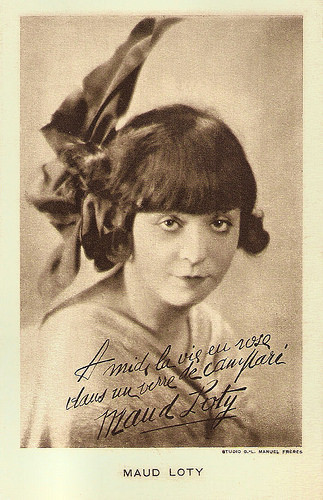
French postcard. Photo: Studio G.L. Manuel Frères. Caption: "A midi la vie en rose dans un verre de Campari."
Maud Loty aka Maud Loti and 'La Maud' (1894-1976), was a popular French vaudeville actress of the 1920s and 1930s, who was also active in silent cinema during the 1910s.
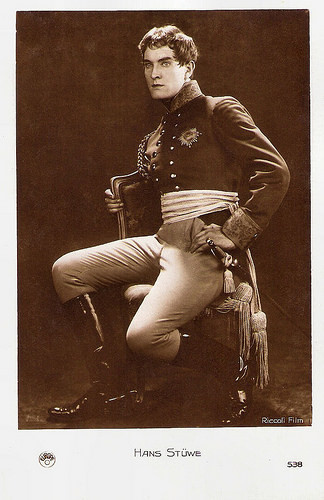
French postcard by Europe, no. 538. Photo: Riccoli Film.
Hans Stüwe (1901-1976) was a German singer and opera director. From 1926 on he was also a big film star in Germany. Four times he was the film partner of Ufa diva Zarah Leander.
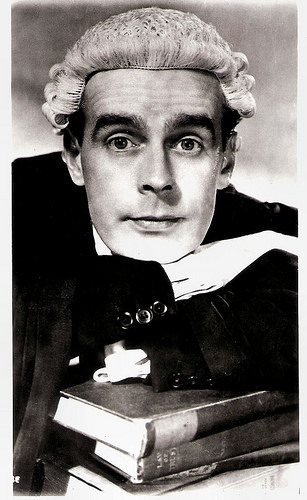
British card by British Lion Films. Publicity still for Brothers in Law (Roy Boulting, 1957).
Unassuming, innocent-eyed and always ingratiating Ian Carmichael (1920-2010) was quite the popular chap in British comedies of the late 1950s and early 1960s. In the comedy Brothers in Law, he starred as a nervous fledgling barrister who brings laughter to the court.
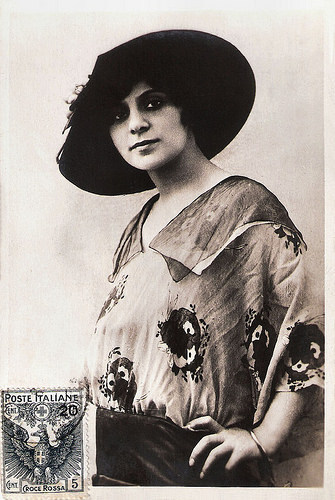
Italian postcard by A.G.F. Sent by mail in 1919.
Italian actress Maria Melato (1885-1950) appeared in the theatre, on radio and in the cinema. Her films included Ritorno/Return (1914), Anna Karenina (1917) and Il volo degli aironi/The flight of the herons (1920). Unfortunately, all her films are considered lost.
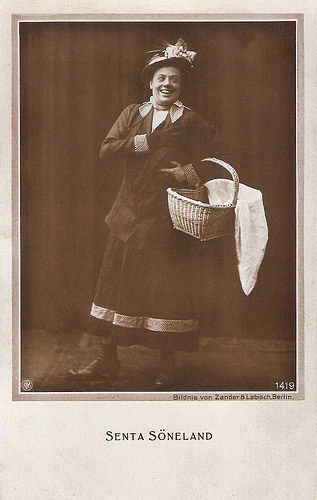
German postcard by NPG, no. 1419. Photo: Zander & Labisch, Berlin.
Senta Söneland (1882-1933) was a German actress whose peaks in her film career were in the later 1910s and the early 1930s.
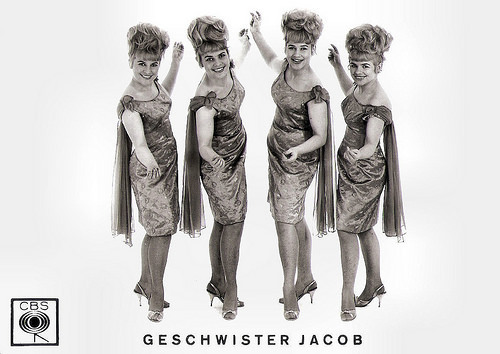
German promotion card, no. 5/60. Photo: CBS.
The Geschwister Jacob (Jacob Sisters) is an incomparable German pop trio. The group was originally a quartet and was composed of the siblings Johanna (1939), Rosi (1941), Eva (1943) and Hannelore Jacob (1944-2008). After Hannelore Jacobs death, but also occasionally in earlier times, the group appeared as a trio. The small, blonde and jolly sisters with their white poodles are always fun, but as senior Heidis or as hamsters on speed they are hilarious.
Next Sunday, the third and final post on our new postcards.

French postcard by Cinémagazine-Edition, Paris, no. 396. Photo: publicity still for The Merry Widow (Erich Von Stroheim, 1925).
American character actor Roy d'Arcy (1894-1969) played his most famous role as the villainous, arrogant Prince Mirko in Erich Von Stroheim’s classic The Merry Widow (1925), starring Mae Murray and John Gilbert. Because of the success of that film, D'Arcy was thrown into several other productions as the head villain, but also in several comedies.

British postcard in the Picturegoer Series, London, no. 71. Photo: Foulsham & Banfield.
British actress Edna Best (1900–1974) was known on the London stage before she entered films in 1921. She is best remembered for her role as the mother in the original 1934 film version of Alfred Hitchcock's The Man Who Knew Too Much. Among her other film credits are Intermezzo: A Love Story (1939), Swiss Family Robinson (1940), The Ghost and Mrs. Muir (1947) and The Iron Curtain (1948).

British postcard by the Picturegoer Series, London, no. B.8. Photo: Warner.
The career of English stage and film actor Claude Rains (1889-1967) spanned 47 years. In Hollywood he was a supporting actor who achieved A-list stardom. With his smooth distinguished voice he could portray a wide variety of roles, ranging from villains to sympathetic gentlemen. He is best known as the title figure in The Invisible Man (1933), as wicked Prince John in The Adventures of Robin Hood (1938), as a corrupt senator in Mr. Smith Goes to Washington (1939), and, of course, as Captain Renault in Casablanca (1942).

German postcard by NPG, no. 405. Photo: Alex Binder, Berlin.
German actress Ida Wüst (1884-1956) was a popular Ufa star in the 1920s and 1930s. She appeared in almost 150 films.

German postcard by NPG, no. 890. Photo: Anny Eberth, Berlin.
Between 1914 and 1922, actress Maria Widal played in the European silent cinema. She started her career as Luzzy Werne (or Werren) in 18 Danish films. From 1916 on, she appeared in the German cinema, where most of her films were directed by Urban Gad.

French postcard by Ed. Chantal, Rueil, Paris, no. 57. Photo: C.P.L.F.
French actress Marie Déa (1912-1992) became famous through two classics of the French cinema, Marcel Carné 's Les Visiteurs du Soir/The Devil's Envoys (1942) and Jean Cocteau's Orphée/Orpheus (1950).

French postcard. Photo: Studio G.L. Manuel Frères. Caption: "A midi la vie en rose dans un verre de Campari."
Maud Loty aka Maud Loti and 'La Maud' (1894-1976), was a popular French vaudeville actress of the 1920s and 1930s, who was also active in silent cinema during the 1910s.

French postcard by Europe, no. 538. Photo: Riccoli Film.
Hans Stüwe (1901-1976) was a German singer and opera director. From 1926 on he was also a big film star in Germany. Four times he was the film partner of Ufa diva Zarah Leander.

British card by British Lion Films. Publicity still for Brothers in Law (Roy Boulting, 1957).
Unassuming, innocent-eyed and always ingratiating Ian Carmichael (1920-2010) was quite the popular chap in British comedies of the late 1950s and early 1960s. In the comedy Brothers in Law, he starred as a nervous fledgling barrister who brings laughter to the court.

Italian postcard by A.G.F. Sent by mail in 1919.
Italian actress Maria Melato (1885-1950) appeared in the theatre, on radio and in the cinema. Her films included Ritorno/Return (1914), Anna Karenina (1917) and Il volo degli aironi/The flight of the herons (1920). Unfortunately, all her films are considered lost.

German postcard by NPG, no. 1419. Photo: Zander & Labisch, Berlin.
Senta Söneland (1882-1933) was a German actress whose peaks in her film career were in the later 1910s and the early 1930s.

German promotion card, no. 5/60. Photo: CBS.
The Geschwister Jacob (Jacob Sisters) is an incomparable German pop trio. The group was originally a quartet and was composed of the siblings Johanna (1939), Rosi (1941), Eva (1943) and Hannelore Jacob (1944-2008). After Hannelore Jacobs death, but also occasionally in earlier times, the group appeared as a trio. The small, blonde and jolly sisters with their white poodles are always fun, but as senior Heidis or as hamsters on speed they are hilarious.
Next Sunday, the third and final post on our new postcards.
Published on April 15, 2015 22:00
April 14, 2015
J.S.A.
During the 1930s and 1940s, the Dutch publisher J.S.A. published dozens of film star postcards. J.S.A. was an abbreviation of J. Sleding, Amsterdam.
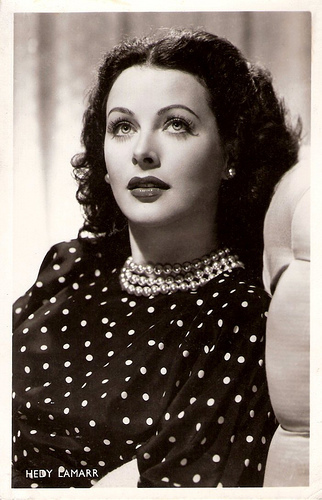
Hedy Lamarr . Dutch postcard by J. Sleding N.V., Amsterdam, no. S 63. Photo: MGM.
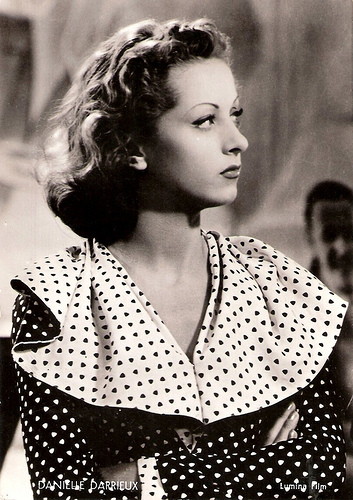
Danielle Darrieux . Dutch postcard by J.S.A. (J. Sleding, Amsterdam), no. 640/516. Photo: Lumina Film.
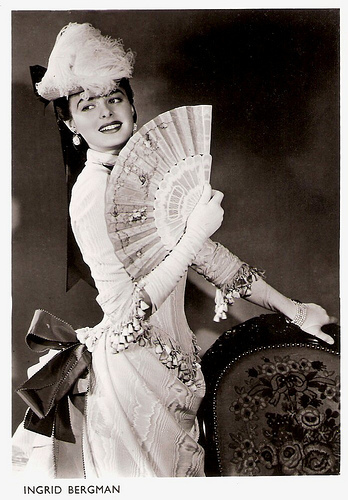
Ingrid Bergman . Dutch postcard by J. Sleding N.V., Amsterdam, no. 102/1250.
Wholesale
Although one can find easily hundreds of postcards of J.S.A. on the web, factual information about the publisher is harder to find. I did a bit of research on the Dutch newspaper database Delfer.
The first mention of J.S.A. was in 1934, when J. Sleding became a limited liability company (in Dutch: NV). The company was located at the time in the Herenstraat, in the heart of old Amsterdam. Sleding was named in the newspaper announcement 'a publisher of postcards en gros (wholesale).'
In 1934, J.S.A. must have existed for some time because there are many older topographical postcards of the publisher. I guess they started at the end of the 19th century. Many of their cards on the net date around 1905-1915, like these postcards at the database of the VVAB.
There are also postcards of film stars of around 1930, like the postcards below of Elga Brink and Renate Müller . These cards all have a white frame, like the Ross postcards from Germany.
Most of the film stars, who were portrayed at the J.S.A. cards of the early 1930s were German stars. Later postcards feature American actors and British actors who worked the big Hollywood studios.
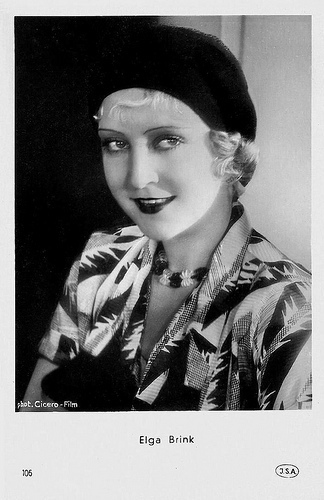
Elga Brink . Dutch postcard by J.S.A., no. 106. Photo: Cicero-Film.
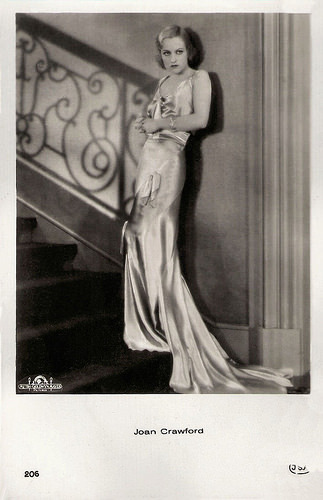
Joan Crawford. Dutch postcard by J.S.A., no. 206. Photo: MGM (Metro-Goldwyn-Mayer).
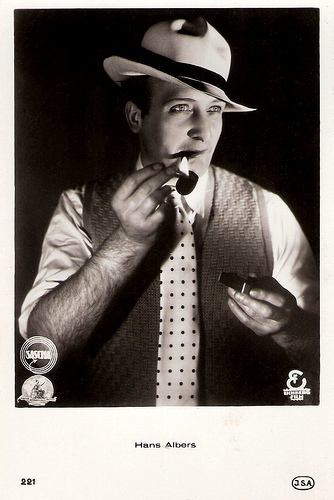
Hans Albers . Dutch postcard by J.S.A., no. 221. Photo: Sascha / Eichberg Film.
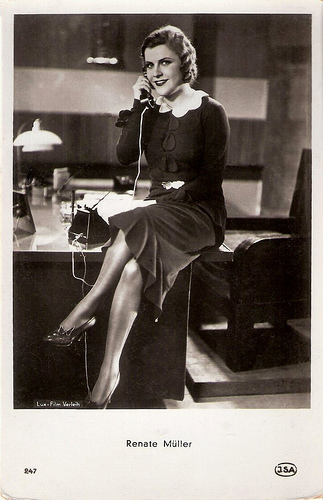
Renate Müller . Dutch postcard by J.S.A., no. 247. Photo: Lux-Film Verleih. Still from Die Privatsekretärin/Private Secretary (Wilhelm Thiele, 1931).
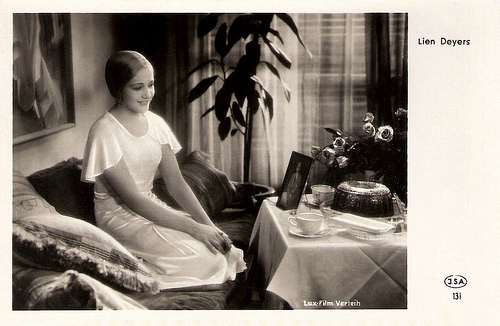
Lien Deyers. Dutch postcard by J.S.A., no. 131. Photo: Lux Film Verleih. Collection: Egbert Barten.
Cityscapes
After World War II, Hollywood films were distributed in the Netherlands by the M.P.E.A. (Motion Picture Export Association). The postcards below were all from this period, the late 1940s. J.S.A. probably stopped publishing film star postcards in the 1950s and focused on topographical subjects.
In 1989 J.S.A. was still located in Amsterdam, now on the Herengracht, one of the major canals of the city. Director was Frans Seegers, who was interviewed by the Dutch newspaper De Telegraaf.
Frans Seegers: "We are mainly engaged in the field of cityscapes. The canals and facades of Amsterdam are much in demand. In addition, the fun cards are also popular, such as those of the poezenboot (the cats boat). Another bestseller is a postcard with a lot of bikes, accompanied by the text 'Greetings from Amsterdam'."
Like many other postcard publishers, J.S.A. does not exist anymore. The company sold its archive around 2000.
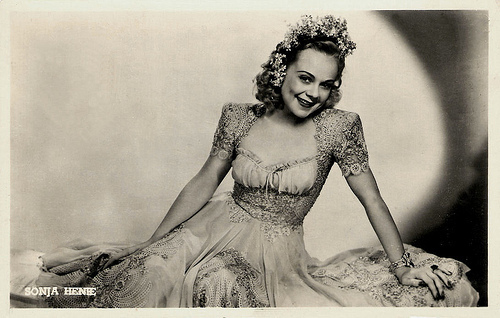
Sonja Henie . Dutch Postcard by J.S.A. Photo: Columbia F.B. / M.P.E.
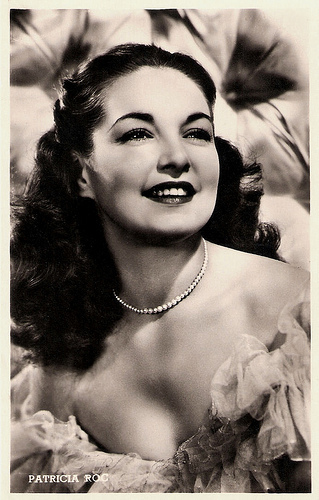
Patricia Roc . Dutch postcard by J.S.A. Photo: Universal / M.P.E.
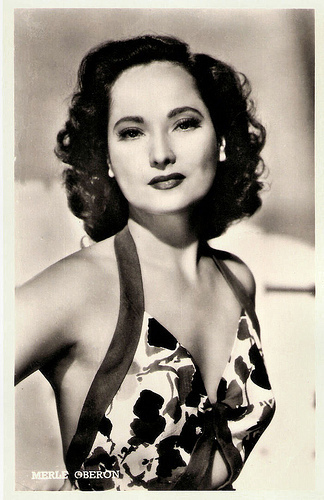
Merle Oberon . Dutch postcard by J.S.A.. Photo: Universal / M.P.E.
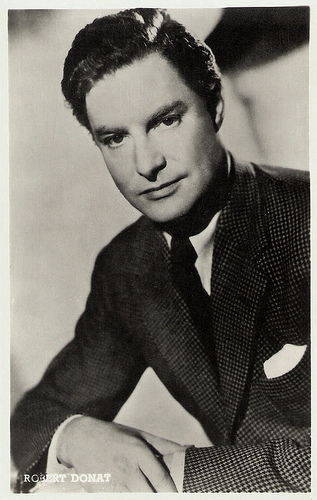
Robert Donat . Dutch postcard by J.S.A. Photo: Metro-Goldwyn-Mayer (MGM).
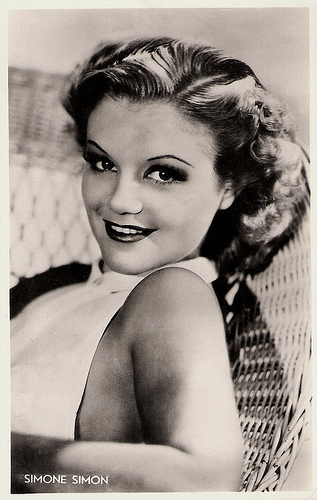
Simone Simon . Dutch postcard by J.S.A. Photo: Century Fox / M.P.E.
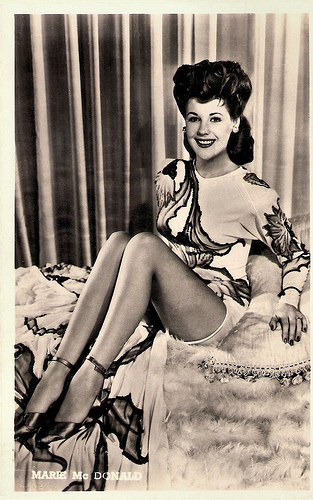
Marie McDonald. Dutch postcard by J.S.A. Photo: Columbia.
This was the fifth post in a new series on film star postcard publishers. Next week: the German company Krüger. For earlier posts, see the links at right under the caption 'The Publishers'.
Sources: Delpher (Dutch) and VVAB (Dutch).

Hedy Lamarr . Dutch postcard by J. Sleding N.V., Amsterdam, no. S 63. Photo: MGM.

Danielle Darrieux . Dutch postcard by J.S.A. (J. Sleding, Amsterdam), no. 640/516. Photo: Lumina Film.

Ingrid Bergman . Dutch postcard by J. Sleding N.V., Amsterdam, no. 102/1250.
Wholesale
Although one can find easily hundreds of postcards of J.S.A. on the web, factual information about the publisher is harder to find. I did a bit of research on the Dutch newspaper database Delfer.
The first mention of J.S.A. was in 1934, when J. Sleding became a limited liability company (in Dutch: NV). The company was located at the time in the Herenstraat, in the heart of old Amsterdam. Sleding was named in the newspaper announcement 'a publisher of postcards en gros (wholesale).'
In 1934, J.S.A. must have existed for some time because there are many older topographical postcards of the publisher. I guess they started at the end of the 19th century. Many of their cards on the net date around 1905-1915, like these postcards at the database of the VVAB.
There are also postcards of film stars of around 1930, like the postcards below of Elga Brink and Renate Müller . These cards all have a white frame, like the Ross postcards from Germany.
Most of the film stars, who were portrayed at the J.S.A. cards of the early 1930s were German stars. Later postcards feature American actors and British actors who worked the big Hollywood studios.

Elga Brink . Dutch postcard by J.S.A., no. 106. Photo: Cicero-Film.

Joan Crawford. Dutch postcard by J.S.A., no. 206. Photo: MGM (Metro-Goldwyn-Mayer).

Hans Albers . Dutch postcard by J.S.A., no. 221. Photo: Sascha / Eichberg Film.

Renate Müller . Dutch postcard by J.S.A., no. 247. Photo: Lux-Film Verleih. Still from Die Privatsekretärin/Private Secretary (Wilhelm Thiele, 1931).

Lien Deyers. Dutch postcard by J.S.A., no. 131. Photo: Lux Film Verleih. Collection: Egbert Barten.
Cityscapes
After World War II, Hollywood films were distributed in the Netherlands by the M.P.E.A. (Motion Picture Export Association). The postcards below were all from this period, the late 1940s. J.S.A. probably stopped publishing film star postcards in the 1950s and focused on topographical subjects.
In 1989 J.S.A. was still located in Amsterdam, now on the Herengracht, one of the major canals of the city. Director was Frans Seegers, who was interviewed by the Dutch newspaper De Telegraaf.
Frans Seegers: "We are mainly engaged in the field of cityscapes. The canals and facades of Amsterdam are much in demand. In addition, the fun cards are also popular, such as those of the poezenboot (the cats boat). Another bestseller is a postcard with a lot of bikes, accompanied by the text 'Greetings from Amsterdam'."
Like many other postcard publishers, J.S.A. does not exist anymore. The company sold its archive around 2000.

Sonja Henie . Dutch Postcard by J.S.A. Photo: Columbia F.B. / M.P.E.

Patricia Roc . Dutch postcard by J.S.A. Photo: Universal / M.P.E.

Merle Oberon . Dutch postcard by J.S.A.. Photo: Universal / M.P.E.

Robert Donat . Dutch postcard by J.S.A. Photo: Metro-Goldwyn-Mayer (MGM).

Simone Simon . Dutch postcard by J.S.A. Photo: Century Fox / M.P.E.

Marie McDonald. Dutch postcard by J.S.A. Photo: Columbia.
This was the fifth post in a new series on film star postcard publishers. Next week: the German company Krüger. For earlier posts, see the links at right under the caption 'The Publishers'.
Sources: Delpher (Dutch) and VVAB (Dutch).
Published on April 14, 2015 22:00
April 13, 2015
Greetings from Utrecht, Part 1
This weekend we visited the International Collectors Fair in Utrecht. It was fun! In three posts we will share 36 of our new acquisitions.
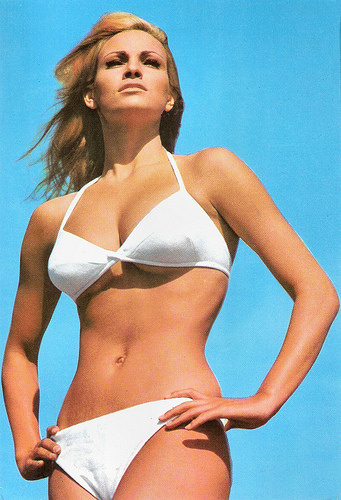
Italian postcard, no. 100/111.
Stunning Swiss sex symbol, starlet and jet-setter Ursula Andress (1936) will always be remembered as the first and quintessential Bond girl. In Dr. No (1962) she made film history when she spectacularly rises out of the Caribbean Sea in a white bikini. Though she won a Golden Globe Ursula's looks generally outweighed her acting talent and she never took her film career very seriously.
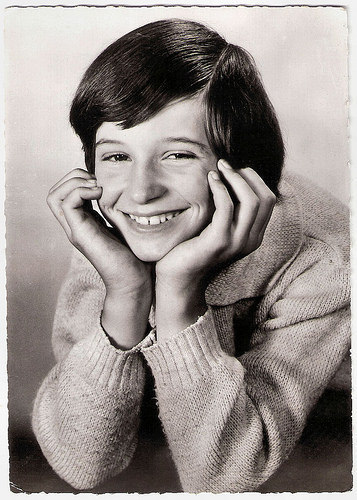
French card. Photo: René Mansat. Publicity still for Zazie dans le métro/Zazie in the Metro (1960).
Catherine Demongeot (1950) made her film debut in the lead role of Zazie dans le metro/Zazie in the Metro (Louis Malle, 1960), based on the novel by Raymond Queneau. She only made two more films. Later on, Demongeot went on to become a teacher.
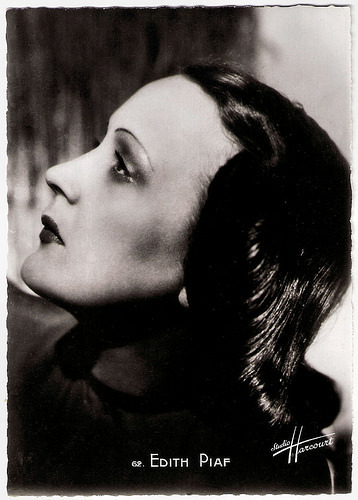
French postcard by S.E.R.P., Paris, no. 62. Photo: Studio Harcourt, Paris.
Édith Piaf (1915–1963) is a cultural icon and is universally regarded as France's greatest popular singer. Her ballads, like La Vie en rose (1946) and Non, je ne regrette rien (1960), reflected her life. She appeared sporadically in films.
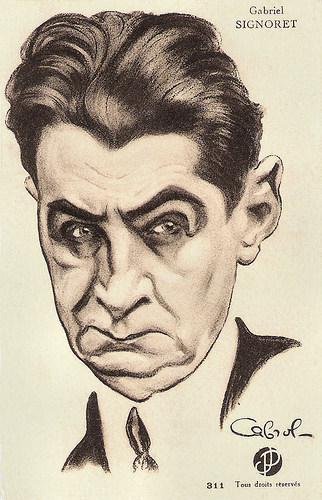
French postcard by Publications J.P., Paris, no. 311. Illustration: Cabrol.
Gabriel Signoret aka Signoret (1878-1937) was a French actor and director who played in some 85 films, mostly silent ones. Raoul Cabrol (1895–1956) was a French caricaturist.
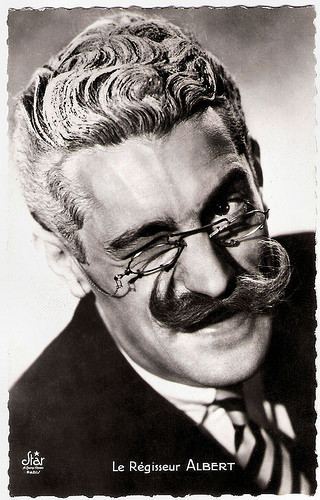
French postcard by Editions P.I., Paris. Photo: Star, Paris.
For French baby boomers, Régisseur Albert is a radio hero from their youth. The radio show he appeared in was called Silence... Antenne , broadcast on Monday evenings at Radio-Inter. Régisseur Albert was played by Pierre Lemaire, who also appeared in some films as Pierre Cour.
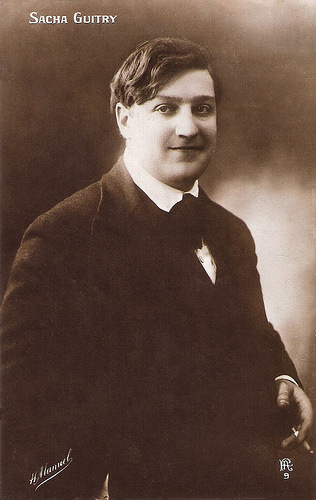
French postcard by F.A., no. 9. Photo: H. Manuel.
French actor, dramatist and director Sacha Guitry (1885-1957) was known for his stage performances, often in the more than 120 plays he wrote. Guitry's plays range from historical dramas to contemporary light comedies. From the 1930s to the end of his life he enthusiastically embraced the cinema, making as many as five films in a single year. After his death, 12,000 people filed past his coffin before his burial in Paris. On 18 May, there will be a special post on Sacha Guitry at EFSP.
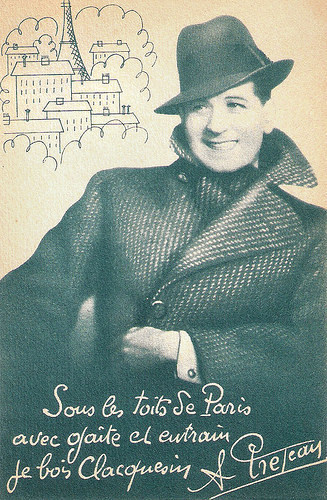
French promotion postcard for Clacquesin, Extrait de Pins. Caption: "For your pleasure, for your health, drink Clacquesin every season. The healthiest Appetizer."
French actor and singer Albert Préjean (1894-1979) was a former WWI flying ace. He is best known for playing heroes in the silent films of René Clair, and for playing George Simenon's detective Maigret.
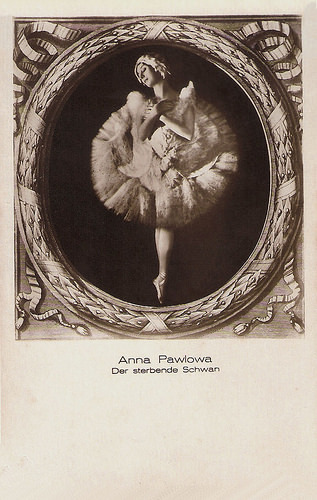
German postcard.
Anna Pavlovna (1881–1931) was a Russian prima ballerina of the late 19th and the early 20th centuries. She was a principal artist of the Imperial Russian Ballet and the Ballets Russes of Sergei Diaghilev. Pavlova is most recognized for the creation of the role The Dying Swan and, with her own company, became the first ballerina to tour ballet around the world.
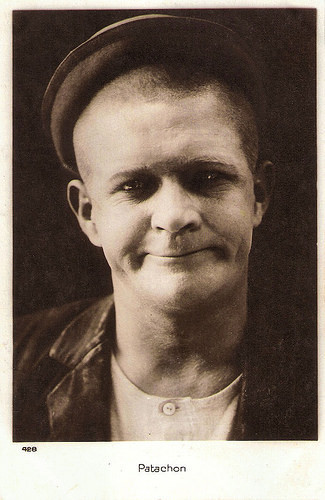
French postcard by Cinémagazine-Edition, Paris, no. 428.
Patachon a.k.a. Harald Madsen (1890-1949) became very popular in the 1920’s as the short half of Danish double-act Fy og Bi (Fyrtårnet og Bivognen or Pat & Patachon). With long Carl Schenstrom, he formed the most famous comedy couple of the European silent cinema. In Europe, their short slapstick films were as popular as the Laurel & Hardy comedies.
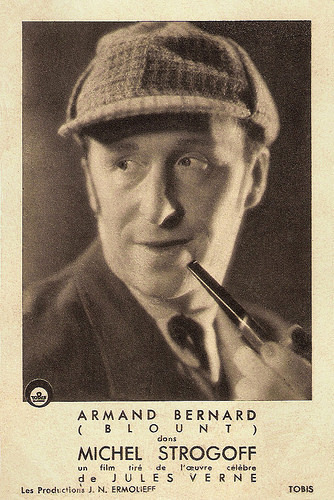
French postcard by Tobis. Photo: Les productions J.N. Ermolieff. Publicity still for Michel Strogoff (Jacques de Baroncelli, Richard Eichberg, 1936).
Armand Bernard (1893-1968) was a French actor, composer and band leader. With his heavy diction and his air of dignity he brought a comical note to many French comedies.

French collectors card by Massilia.
French actor and war hero Jean Gabin (1904-1976) was one of the great stars of the European cinema. In the 1930s he became the personification of the tragic romantic hero of the poetic realist film. Whether he played a legionnaire in Gueule d'amour , a deserter in Le Quai des brumes or the head gangster in Pépé le Moko, Gabin was impeccable, bringing a tragic humanity to each of his appearances which the public adored. After the war Gabin was reborn as a tough anti-hero, set in his beliefs, feared and respected by all, the Godfather of French cinema.

Spanish postcard, no. 11.
American actress Raquel Welch (1940) is one of the icons of the 1960s and 1970s. She first won attention for her role in Fantastic Voyage (1966). In Great Britain, she then made One Million Years B.C. (1966). Although she had only three lines in the film, a poster of Welch in a furry prehistoric bikini became an amazing bestseller and catapulted her to stardom.
Next thursday, 12 more postcards we found at the International Collectors Fair in Utrecht.

Italian postcard, no. 100/111.
Stunning Swiss sex symbol, starlet and jet-setter Ursula Andress (1936) will always be remembered as the first and quintessential Bond girl. In Dr. No (1962) she made film history when she spectacularly rises out of the Caribbean Sea in a white bikini. Though she won a Golden Globe Ursula's looks generally outweighed her acting talent and she never took her film career very seriously.

French card. Photo: René Mansat. Publicity still for Zazie dans le métro/Zazie in the Metro (1960).
Catherine Demongeot (1950) made her film debut in the lead role of Zazie dans le metro/Zazie in the Metro (Louis Malle, 1960), based on the novel by Raymond Queneau. She only made two more films. Later on, Demongeot went on to become a teacher.

French postcard by S.E.R.P., Paris, no. 62. Photo: Studio Harcourt, Paris.
Édith Piaf (1915–1963) is a cultural icon and is universally regarded as France's greatest popular singer. Her ballads, like La Vie en rose (1946) and Non, je ne regrette rien (1960), reflected her life. She appeared sporadically in films.

French postcard by Publications J.P., Paris, no. 311. Illustration: Cabrol.
Gabriel Signoret aka Signoret (1878-1937) was a French actor and director who played in some 85 films, mostly silent ones. Raoul Cabrol (1895–1956) was a French caricaturist.

French postcard by Editions P.I., Paris. Photo: Star, Paris.
For French baby boomers, Régisseur Albert is a radio hero from their youth. The radio show he appeared in was called Silence... Antenne , broadcast on Monday evenings at Radio-Inter. Régisseur Albert was played by Pierre Lemaire, who also appeared in some films as Pierre Cour.

French postcard by F.A., no. 9. Photo: H. Manuel.
French actor, dramatist and director Sacha Guitry (1885-1957) was known for his stage performances, often in the more than 120 plays he wrote. Guitry's plays range from historical dramas to contemporary light comedies. From the 1930s to the end of his life he enthusiastically embraced the cinema, making as many as five films in a single year. After his death, 12,000 people filed past his coffin before his burial in Paris. On 18 May, there will be a special post on Sacha Guitry at EFSP.

French promotion postcard for Clacquesin, Extrait de Pins. Caption: "For your pleasure, for your health, drink Clacquesin every season. The healthiest Appetizer."
French actor and singer Albert Préjean (1894-1979) was a former WWI flying ace. He is best known for playing heroes in the silent films of René Clair, and for playing George Simenon's detective Maigret.

German postcard.
Anna Pavlovna (1881–1931) was a Russian prima ballerina of the late 19th and the early 20th centuries. She was a principal artist of the Imperial Russian Ballet and the Ballets Russes of Sergei Diaghilev. Pavlova is most recognized for the creation of the role The Dying Swan and, with her own company, became the first ballerina to tour ballet around the world.

French postcard by Cinémagazine-Edition, Paris, no. 428.
Patachon a.k.a. Harald Madsen (1890-1949) became very popular in the 1920’s as the short half of Danish double-act Fy og Bi (Fyrtårnet og Bivognen or Pat & Patachon). With long Carl Schenstrom, he formed the most famous comedy couple of the European silent cinema. In Europe, their short slapstick films were as popular as the Laurel & Hardy comedies.

French postcard by Tobis. Photo: Les productions J.N. Ermolieff. Publicity still for Michel Strogoff (Jacques de Baroncelli, Richard Eichberg, 1936).
Armand Bernard (1893-1968) was a French actor, composer and band leader. With his heavy diction and his air of dignity he brought a comical note to many French comedies.

French collectors card by Massilia.
French actor and war hero Jean Gabin (1904-1976) was one of the great stars of the European cinema. In the 1930s he became the personification of the tragic romantic hero of the poetic realist film. Whether he played a legionnaire in Gueule d'amour , a deserter in Le Quai des brumes or the head gangster in Pépé le Moko, Gabin was impeccable, bringing a tragic humanity to each of his appearances which the public adored. After the war Gabin was reborn as a tough anti-hero, set in his beliefs, feared and respected by all, the Godfather of French cinema.

Spanish postcard, no. 11.
American actress Raquel Welch (1940) is one of the icons of the 1960s and 1970s. She first won attention for her role in Fantastic Voyage (1966). In Great Britain, she then made One Million Years B.C. (1966). Although she had only three lines in the film, a poster of Welch in a furry prehistoric bikini became an amazing bestseller and catapulted her to stardom.
Next thursday, 12 more postcards we found at the International Collectors Fair in Utrecht.
Published on April 13, 2015 22:00
April 12, 2015
Bono
Bono is the stage name of Irish singer-songwriter and musician Paul David Hewson (1960), front man of the Dublin-based rock band U2. With or without U2, he also appeared in several feature films and documentaries.
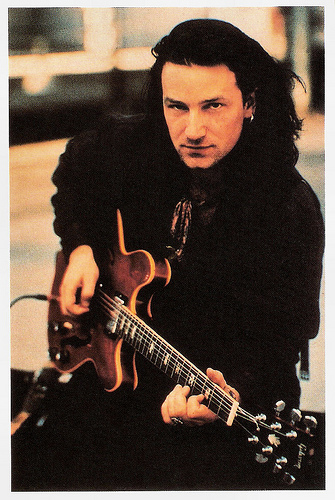
British postcard by New Line, no. 46. Photo: Transworld B.V. Entertainment.
A surrealist street gang
Bono was born in Dublin, Ireland, in 1960. He was also raised there. Bono was 14 when his mother died in 1974 after suffering a cerebral aneurysm at her father's funeral. Many U2 songs, including I Will Follow, focus on the loss of his mother.
Bono and his friends were part of a surrealist street gang called ‘Lypton Village’. The gang had a ritual of nickname-giving and Bono had several names, including ‘Bono Vox of O'Connell Street’. ‘Bono Vox’ is an alteration of Bonavox, Latin for ‘good voice’. It is said he was nicknamed ‘Bono Vox’ by his friend Gavin Friday.
He attended Mount Temple Comprehensive School, where he met his future wife, Alison Stewart, and the future members of U2. In 1976, Bono, David Evans (‘The Edge’), his brother Dik and Adam Clayton responded to an advertisement on a bulletin board at Mount Temple posted by fellow student Larry Mullen Jr. to form a rock band.
The band had occasional jam sessions in which they did covers of other bands. Unfortunately the band could not play covers very well, so they started writing their own songs. The band went by the name Feedback for a few months, before changing to The Hype later on. After Dik Evans left the group to join another local band, the Virgin Prunes, the remaining four officially changed the name from The Hype to U2.
Initially Bono sang, played guitar and wrote the band's songs. When The Edge's guitar playing improved, Bono was relegated mostly to the microphone, although he occasionally still plays rhythm guitar and harmonica. During the band's early years, Bono was known for his rebellious tone which turned to political anger and rage during the band's War, The Joshua Tree and Rattle and Hum eras. Bono writes almost all U2 lyrics, frequently using religious, social, and political themes.
U2's sound and focus dramatically changed with their 1991 album, Achtung Baby. Bono's lyrics became more personal, inspired by experiences related to the private lives of the members of the band. Outside U2, Bono has collaborated and recorded with numerous artists, including Frank Sinatra, Johnny Cash and Zucchero. Bono and The Edge also wrote the music and lyrics for the ill-fated Broadway musical Spider-Man: Turn Off the Dark (2011), directed by Julie Taymor.
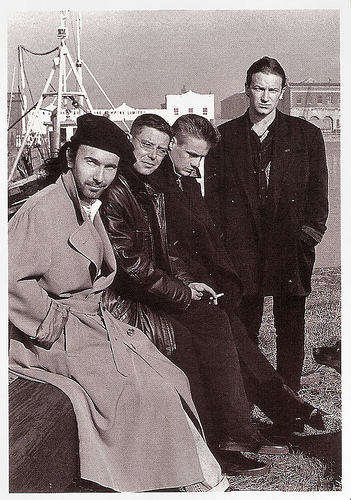
French postcard, Ref 537.

French postcard by Editions RRV, no. C 45.
Rockumentary
Besides his videos for U2, Bono also appeared in several films. In 1988, U2 made the Rockumentary Rattle and Hum (Phil Joanou, 1988), about their North American tour of the year before. Fresh with their success of their best selling album, The Joshua Tree, U2 plays monster gigs. Along the way, the band takes the opportunity in indulge in some special musical activities like playing with BB King and performing ‘I Still Haven't Found What I'm Looking For’ with a church choir.
Director Phil Joanou made Entropy (1999), starring Stephen Dorff and featuring U2. The film is largely autobiographical, covering Joanou’s early film career, his relationships and his pet cat.
Bono worked regularly with German director Wim Wenders. He contributed songs to the soundtracks of the futurist road movie Until the End of the World (Wim Wenders, 1991), and the Wings of Desire (1987) sequel Faraway, So Close! (Wim Wenders, 1993). Bono wrote the concept story for The Million Dollar Hotel (Wim Wenders, 2000), starring Jeremy Davies, Milla Jovovich, and Mel Gibson. The film, which Bono also co-produced, features music by U2 and Bono did a cameo appearance. The Million Dollar Hotel won the Silver Bear at the Berlin International Film Festival in 2000, but was a box office flop.
Bono also had a cameo appearance in Across the Universe (Julie Taymor, 2007), centred on songs by The Beatles . In 2011 followed the documentary From the Sky Down (David Guggenheim, 2011) about the production of U2’s 1991 album Achtung Baby.
Bono is also managing director and a managing partner of Elevation Partners, and has refurbished and owns the Clarence Hotel in Dublin with The Edge. Bono is also widely known for his activism concerning Africa. He has organized and played in several benefit concerts and has met with influential politicians. Bono took part in Bob Geldof's Do They Know It's Christmas (1984) project to combat famine in Africa, and the anti-South African apartheid documentary Sun City - Artists United Against Apartheid (1985).
Bono has been praised and criticized for his activism and involvement with U2. He was granted a knighthood by Queen Elizabeth II of the United Kingdom, and, with Bill and Melinda Gates, was named Time Person of the Year in 2005, among other awards and nominations. In 2013, Bono was made a Commandeur of the French Ordre des Arts et des Lettres (Order of Arts and Letters). U2 has won 22 Grammy Awards to date and Bono is the only person, who has been nominated for an Oscar, Grammy, Golden Globe, and for the Nobel Prize.
Since 1982, Bono is married to Alison (Ali) Stewart and they have four children, including actress Eve Hewson.

French postcard by Editions Damilla, Paris, no. 94983. Photo: Tom Sheehan.
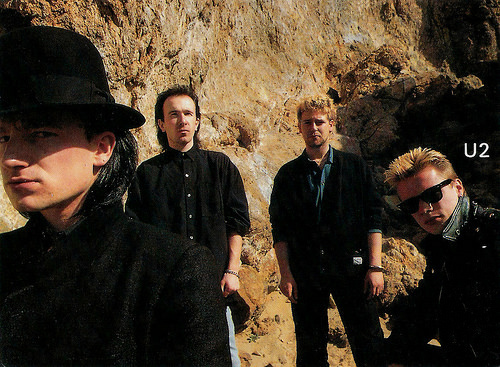
British postcard by Holmes McDougall Ltd, Edinburgh, no. PC 226. Photo: Minerva, 1988.
Trailer Rattle and Hum (1988). Source: Paramount Movies (YouTube).
Trailer The Million Dollar Hotel (2000). Source: Exclusive Media (YouTube).
Sources: Lucia Bozzola (AllMovie), Wikipedia, and .

British postcard by New Line, no. 46. Photo: Transworld B.V. Entertainment.
A surrealist street gang
Bono was born in Dublin, Ireland, in 1960. He was also raised there. Bono was 14 when his mother died in 1974 after suffering a cerebral aneurysm at her father's funeral. Many U2 songs, including I Will Follow, focus on the loss of his mother.
Bono and his friends were part of a surrealist street gang called ‘Lypton Village’. The gang had a ritual of nickname-giving and Bono had several names, including ‘Bono Vox of O'Connell Street’. ‘Bono Vox’ is an alteration of Bonavox, Latin for ‘good voice’. It is said he was nicknamed ‘Bono Vox’ by his friend Gavin Friday.
He attended Mount Temple Comprehensive School, where he met his future wife, Alison Stewart, and the future members of U2. In 1976, Bono, David Evans (‘The Edge’), his brother Dik and Adam Clayton responded to an advertisement on a bulletin board at Mount Temple posted by fellow student Larry Mullen Jr. to form a rock band.
The band had occasional jam sessions in which they did covers of other bands. Unfortunately the band could not play covers very well, so they started writing their own songs. The band went by the name Feedback for a few months, before changing to The Hype later on. After Dik Evans left the group to join another local band, the Virgin Prunes, the remaining four officially changed the name from The Hype to U2.
Initially Bono sang, played guitar and wrote the band's songs. When The Edge's guitar playing improved, Bono was relegated mostly to the microphone, although he occasionally still plays rhythm guitar and harmonica. During the band's early years, Bono was known for his rebellious tone which turned to political anger and rage during the band's War, The Joshua Tree and Rattle and Hum eras. Bono writes almost all U2 lyrics, frequently using religious, social, and political themes.
U2's sound and focus dramatically changed with their 1991 album, Achtung Baby. Bono's lyrics became more personal, inspired by experiences related to the private lives of the members of the band. Outside U2, Bono has collaborated and recorded with numerous artists, including Frank Sinatra, Johnny Cash and Zucchero. Bono and The Edge also wrote the music and lyrics for the ill-fated Broadway musical Spider-Man: Turn Off the Dark (2011), directed by Julie Taymor.

French postcard, Ref 537.

French postcard by Editions RRV, no. C 45.
Rockumentary
Besides his videos for U2, Bono also appeared in several films. In 1988, U2 made the Rockumentary Rattle and Hum (Phil Joanou, 1988), about their North American tour of the year before. Fresh with their success of their best selling album, The Joshua Tree, U2 plays monster gigs. Along the way, the band takes the opportunity in indulge in some special musical activities like playing with BB King and performing ‘I Still Haven't Found What I'm Looking For’ with a church choir.
Director Phil Joanou made Entropy (1999), starring Stephen Dorff and featuring U2. The film is largely autobiographical, covering Joanou’s early film career, his relationships and his pet cat.
Bono worked regularly with German director Wim Wenders. He contributed songs to the soundtracks of the futurist road movie Until the End of the World (Wim Wenders, 1991), and the Wings of Desire (1987) sequel Faraway, So Close! (Wim Wenders, 1993). Bono wrote the concept story for The Million Dollar Hotel (Wim Wenders, 2000), starring Jeremy Davies, Milla Jovovich, and Mel Gibson. The film, which Bono also co-produced, features music by U2 and Bono did a cameo appearance. The Million Dollar Hotel won the Silver Bear at the Berlin International Film Festival in 2000, but was a box office flop.
Bono also had a cameo appearance in Across the Universe (Julie Taymor, 2007), centred on songs by The Beatles . In 2011 followed the documentary From the Sky Down (David Guggenheim, 2011) about the production of U2’s 1991 album Achtung Baby.
Bono is also managing director and a managing partner of Elevation Partners, and has refurbished and owns the Clarence Hotel in Dublin with The Edge. Bono is also widely known for his activism concerning Africa. He has organized and played in several benefit concerts and has met with influential politicians. Bono took part in Bob Geldof's Do They Know It's Christmas (1984) project to combat famine in Africa, and the anti-South African apartheid documentary Sun City - Artists United Against Apartheid (1985).
Bono has been praised and criticized for his activism and involvement with U2. He was granted a knighthood by Queen Elizabeth II of the United Kingdom, and, with Bill and Melinda Gates, was named Time Person of the Year in 2005, among other awards and nominations. In 2013, Bono was made a Commandeur of the French Ordre des Arts et des Lettres (Order of Arts and Letters). U2 has won 22 Grammy Awards to date and Bono is the only person, who has been nominated for an Oscar, Grammy, Golden Globe, and for the Nobel Prize.
Since 1982, Bono is married to Alison (Ali) Stewart and they have four children, including actress Eve Hewson.

French postcard by Editions Damilla, Paris, no. 94983. Photo: Tom Sheehan.

British postcard by Holmes McDougall Ltd, Edinburgh, no. PC 226. Photo: Minerva, 1988.
Trailer Rattle and Hum (1988). Source: Paramount Movies (YouTube).
Trailer The Million Dollar Hotel (2000). Source: Exclusive Media (YouTube).
Sources: Lucia Bozzola (AllMovie), Wikipedia, and .
Published on April 12, 2015 22:00
April 11, 2015
Madeleine Robinson
Madeleine Robinson (1917-2004) was a French-Czech, later naturalized Swiss actress. Determinedly independent, she was known for the intensity of her performances but also for her fiery temperament off stage and screen. From 1934 on, she played in 80 films and in numerous TV productions and stage plays and became one France’s most respected actresses. Her film career included several masterpieces like Une si jolie petite plage/Riptide (1949), Dieu a besoin des hommes/God Needs Men (1950) and Orson Welles’ Le Procès/The Trial (1962).
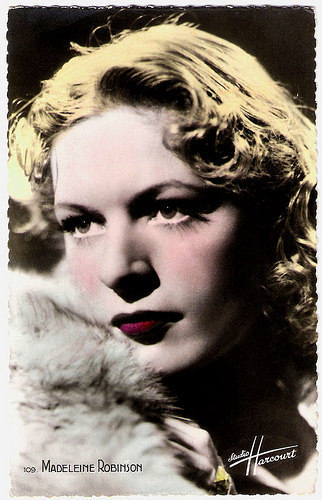
French postcard by S.E.R.P., Paris, no. 109. Photo: Studio Harcourt.
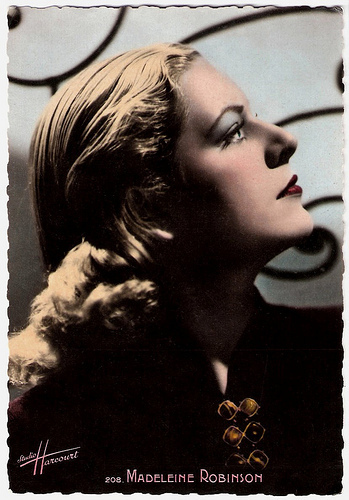
French postcard by S.E.R.P., Paris, no. 208. Photo: Studio Harcourt.
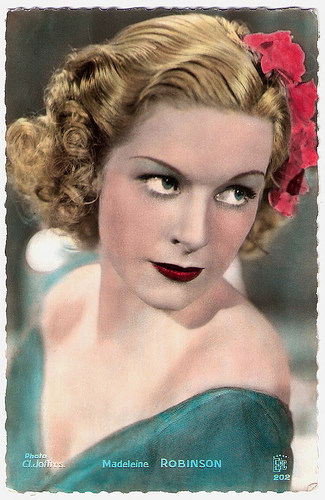
French postcard by EPC (Editions et Publications Cinématographiques), no. 202. Photo: Cl. Joffres.
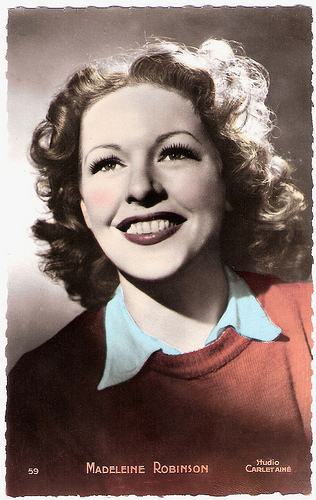
French postcard by Editions P.I., Paris. no. 59. Offert par les Carbones Korès. Photo: Studio Carlet Ainé.
Strange and intriguing
Madeleine Robinson was born as Yvonne Madeleine Svoboda in Paris in 1917. Her parents, Victor and Suzanne Svoboda, were Czech immigrants, who had come very young to France. Her father was a baker and her mother a tram ticket collector. Her parents separated when she was ten years old.
Madeleine had three brothers and the family was very poor. At 14, she began to work, first as a factory worker and later as a messenger girl and as a maid in the house of an artist. She was admitted as a free listener by Charles Dullin to follow his drama classes at the Théâtre de l'Atelier. Dullin was highly regarded as the teacher of a revolutionary approach to drama eschewing realism in favour of stylisation. Fellow students included Jean Marais and Jean Vilar.
To support herself, she posed as a model for pictures and worked as an extra. She chose the pseudonym ‘Robinson’ because of her childhood memory of reading Robinson Crusoe. He was the image of a free man and her Czech birth name meant ‘freedom’. At the age of 18, she started her film career with a bit role in Tartarin de Tarascon/Tartarin of Tarascon (Raymond Bernard, 1934).
Two years later, she played a starring role as a young mother in the comedy Mioche/40 Girls and a Baby (Léonide Moguy, 1936). Conrad Veidt and Sessue Hayakawa were her co-stars in the drama Tempête sur l'Asie/Storm Over Asia (Richard Oswald, 1938). Oswald and Veidt were both exiles from Germany, and would soon leave for Hollywood.
During the German occupation of France, she made a few of her best films. Strange and intriguing is Lumière d'été/Summer Light (Jean Gremillon, 1942), written by Jacques Prévert. In an isolated mountain hotel, Robinson is a naïve young woman who has come to meet her dissolute fiancé ( Pierre Brasseur ), a drunken artist. Disappointed in the soullessness of this society and disillusioned by her fiancé, she is drawn to a young engineer (Georges Marchal) whose values eventually inspire her to love. The film was banned by the Vichy authorities for its allegorical attack on the decadence and corruption of the ruling classes.
Also interesting are the drama Douce/Love Story (Claude Autant-Lara, 1943) with Odette Joyeux , and the horror film Sortilèges/The Bellman (Christian-Jaque, 1945).
After the war, Robinson starred opposite Jean Marais in the historical drama Les Chouans/The Royalists (Henri Calef, 1947), an adaptation of a novel by Honoré de Balzac. DB DuMonteil at IMDb : “Marais' aristocratic style and his stunning charisma made the film a winner. He will meet two beautiful women: the first is Madame de Gua, a royalist, one of the chiefs of the chouans, these people who could not accept that their country had become a republic. She is played by a great actress, Madeleine Robinson, who gives a flawless performance: like Marais, she's able to convey subtle feelings from an intense hate to a delicate frailty. The second, Marie de Verneuil is a spy in the pay of the Republicans. Madeleine Lebeau is not exactly on a par with her two tremendous co-stars, but she makes all her scenes count.”
Another highlight was the film noir Une si jolie petite plage/Riptide (Yves Allégret, 1949) with Gérard Philippe as a fugitive at a desolate seaside resort in rainy Normandy in winter. Robinson is a dishevelled chambermaid, who vainly tries to rescue him from despair.
Also remarkable were Dieu a besoin des hommes/God Needs Men (Jean Delannoy, 1950) starring Pierre Fresnay , and the drama L'affaire Maurizius/On Trial (Julien Duvivier, 1954) in which she co-starred with Daniel Gélin and Anton Walbrook .
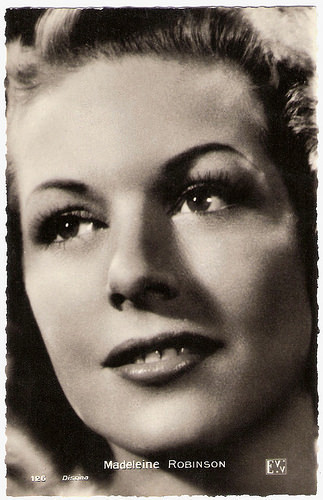
French postcard by Editions Votre Vedette (E.V.V.), no. 126. Photo: Discina.
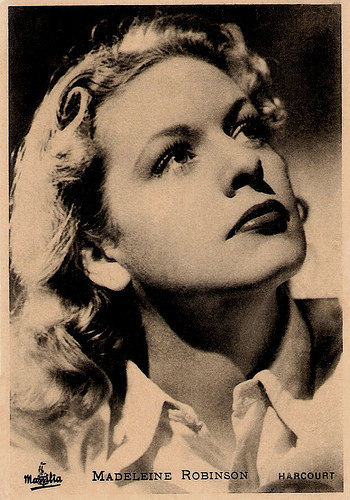
French collectors card by Massilia. Photo: Studio Harcourt.
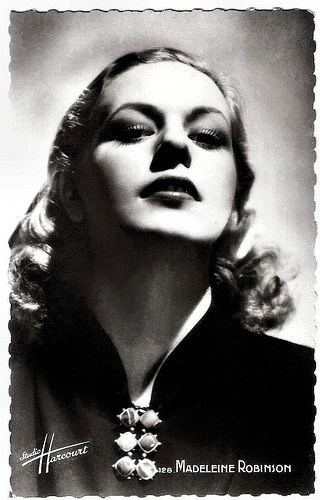
French postcard by SERP, no. 128. Photo: Studio Harcourt.
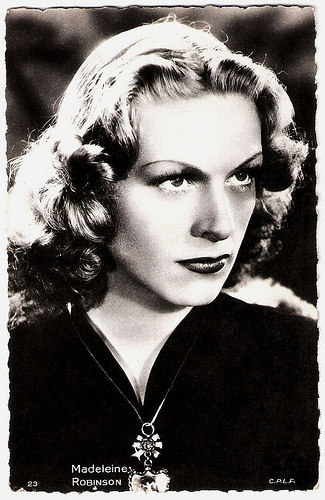
French postcard by Editions Chantal, Rueil, no. 23. Photo: C.P.L.F.
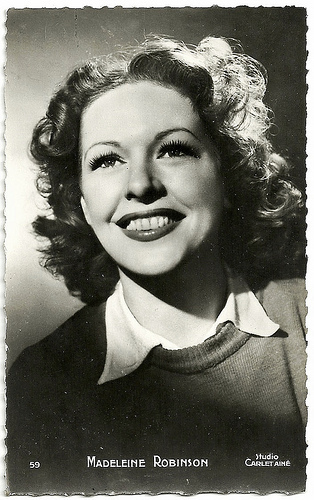
French postcard by Editions P.I., Paris, no. 59. Photo: Studio Carlet Ainé. Offert par les Carbones Korès.
Who's Afraid of Virginia Woolf?
Madeleine Robinson starred in many stage plays. Between 1954 and 1972, she performed several times the play Adorable Julia (Being Julia) by Somerset Maugham. It was also broadcasted on television. Her second big hit in the theatre was Noix de coco (Coconut) by Marcel Achard, which was filmed for television too.
She continued to appear in films, but had to wait nearly a decade for a plum role. Ronald Bergan in The Guardian : “For much of the 1950s, Robinson made films for, in her words, raisons alimentaires, but later benefited from better roles as a mature woman.”
In Claude Chabrol's study of a dysfunctional bourgeois family, A Double Tour/Web Of Passion (1959), she played the neurotic wife of an adulterous wine merchant. Not one of Chabrol's best films, but it earned Robinson the best actress award at the 1959 Venice film festival.
In 1962, she played Mrs. Grubach, the landlady of Josef K. (Anthony Perkins) in Orson Welles ’ Le Procès/The Trial (1962), based on Franz Kafka’s classic novel.
On stage, she played Martha in the play Qui a peur de Virginia Woolf? (Who's Afraid of Virginia Woolf?) by Edward Albee. For her part she was rewarded with the Prize for Best Actress by the Syndicat de la critique (Union of the Critics) in 1965. This production, directed by Franco Zeffirelli, also caused a controversy, because of her problems with co-star Raymond Gérôme. He took her to court over a spat during rehearsals. She lost.
This attributed to her reputation of having a ‘bad temper’. The Telegraph : “She became a legend on the boards and on set for brooking no challenge to how she thought a part should be played. Many were the directors and colleagues with whom she fought bitterly on such matters.”
Vittorio De Sica directed her in the film Un monde nouveau/A New World (1966) with Nino Castelnuovo. In the theatre, she played leading roles in A Streetcar Named Desire by Tennessee Williams and in Bertolt Brecht's Mother Courage.
In 1977, she played Aunt Leo in Parents Terribles (Terrible parents) by Jean Cocteau, in which Jean Marais was her partner and director.
Two years later she appeared in the Spanish film Siete días de enero/Seven Days in January (Juan Antonio Bardem, 1979) about the 1977 Massacre of Atocha. It was entered into the 11th Moscow International Film Festival where it won the Golden Prize.
Very successful was the biopic Camille Claudel (Bruno Nuytten, 1988) in which she played the narrow-minded mother of schizophrenic sculptor Camille Claudel ( Isabelle Adjani ). Her last screen appearance was in the TV-film L'Enfant en héritage/A Child's Inheritance (Josée Dayan, 1992).
In 2001, she received a honorary Molière award for lifetime achievement. She was married to actor Robert Dalban with whom she had a son, Jean-François (1941), to Guillaume Amestoy and ahe lived with Spanish actor-writer Jose Luis de Villalonga. From her relationship with the singer Jean-Louis Jaubert of the group Compagnons de la chanson, she had a daughter, Sophie-Julia (1955-1993).
For years, Madeleine Robinson lived in retirement in Montreux in Switzerland. She was garlanded with many awards including the Legion of Honour, the National Order of Merit, and Commander of Arts and Letters. Her companion was a poodle which she had named Vendredi (Friday). At the age of 86, she died in 2004 in Lausanne, Switzerland.
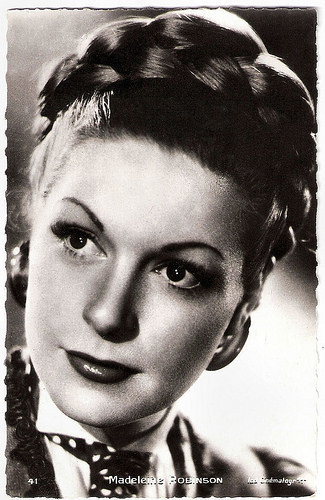
French postcard Ind. Cinematogr, no. 41.
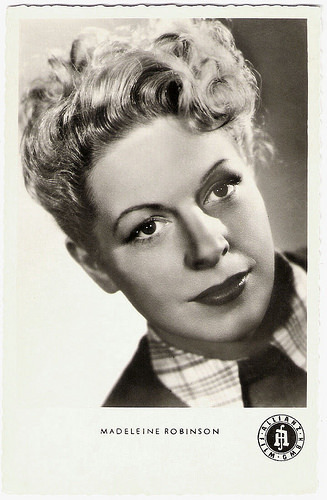
German postcard by Kunst und Bild, Berlin, no. 187. Photo: Allianz-Film.
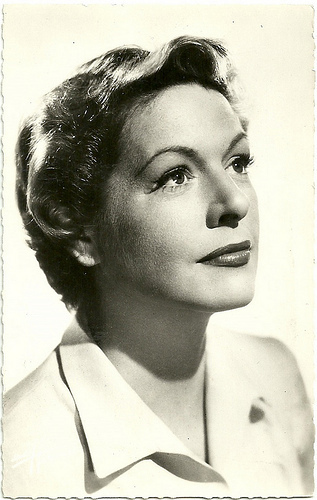
French postcard by Editions du Globe, Paris.
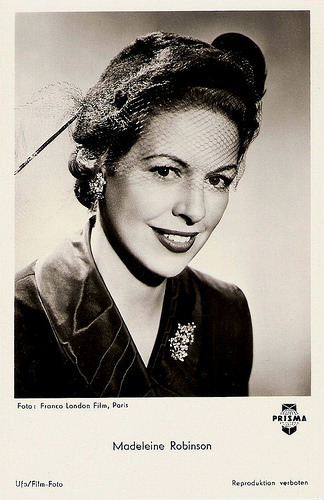
German postcard by Ufa, Berlin-Tempelhof, no. FK 1504. Photo: Franco London Film, Paris / Prisma. Publicity still for L'affaire Maurizius/On Trial (Julien Duvivier, 1954).
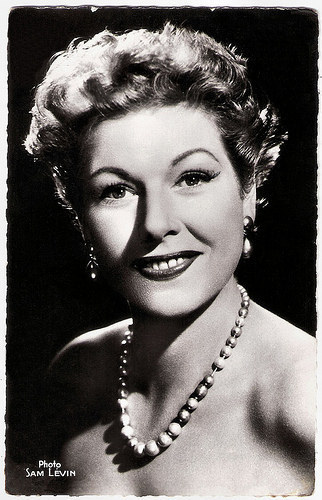
French postcard by Editions du Globe, Paris, no. 195. Photo: Sam Lévin.
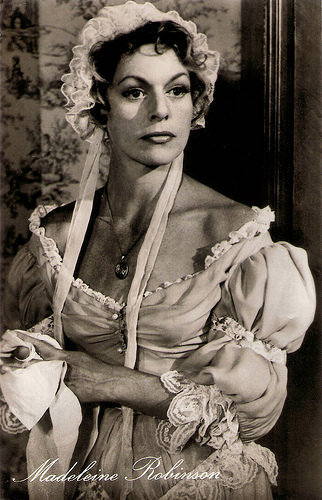
East-German postcard by VEB Progress Filmvertrieb, Berlin, no. 1133. Photo: DEFA-Pathenheimer. Publicity still for the film Les arrivistes/Trübe Wasser/The Opportunists (Louis Daquin, 1960).
Sources: Ronald Bergan (The Guardian), The Telegraph, AllMovie, Wikipedia (French and English) and .

French postcard by S.E.R.P., Paris, no. 109. Photo: Studio Harcourt.

French postcard by S.E.R.P., Paris, no. 208. Photo: Studio Harcourt.

French postcard by EPC (Editions et Publications Cinématographiques), no. 202. Photo: Cl. Joffres.

French postcard by Editions P.I., Paris. no. 59. Offert par les Carbones Korès. Photo: Studio Carlet Ainé.
Strange and intriguing
Madeleine Robinson was born as Yvonne Madeleine Svoboda in Paris in 1917. Her parents, Victor and Suzanne Svoboda, were Czech immigrants, who had come very young to France. Her father was a baker and her mother a tram ticket collector. Her parents separated when she was ten years old.
Madeleine had three brothers and the family was very poor. At 14, she began to work, first as a factory worker and later as a messenger girl and as a maid in the house of an artist. She was admitted as a free listener by Charles Dullin to follow his drama classes at the Théâtre de l'Atelier. Dullin was highly regarded as the teacher of a revolutionary approach to drama eschewing realism in favour of stylisation. Fellow students included Jean Marais and Jean Vilar.
To support herself, she posed as a model for pictures and worked as an extra. She chose the pseudonym ‘Robinson’ because of her childhood memory of reading Robinson Crusoe. He was the image of a free man and her Czech birth name meant ‘freedom’. At the age of 18, she started her film career with a bit role in Tartarin de Tarascon/Tartarin of Tarascon (Raymond Bernard, 1934).
Two years later, she played a starring role as a young mother in the comedy Mioche/40 Girls and a Baby (Léonide Moguy, 1936). Conrad Veidt and Sessue Hayakawa were her co-stars in the drama Tempête sur l'Asie/Storm Over Asia (Richard Oswald, 1938). Oswald and Veidt were both exiles from Germany, and would soon leave for Hollywood.
During the German occupation of France, she made a few of her best films. Strange and intriguing is Lumière d'été/Summer Light (Jean Gremillon, 1942), written by Jacques Prévert. In an isolated mountain hotel, Robinson is a naïve young woman who has come to meet her dissolute fiancé ( Pierre Brasseur ), a drunken artist. Disappointed in the soullessness of this society and disillusioned by her fiancé, she is drawn to a young engineer (Georges Marchal) whose values eventually inspire her to love. The film was banned by the Vichy authorities for its allegorical attack on the decadence and corruption of the ruling classes.
Also interesting are the drama Douce/Love Story (Claude Autant-Lara, 1943) with Odette Joyeux , and the horror film Sortilèges/The Bellman (Christian-Jaque, 1945).
After the war, Robinson starred opposite Jean Marais in the historical drama Les Chouans/The Royalists (Henri Calef, 1947), an adaptation of a novel by Honoré de Balzac. DB DuMonteil at IMDb : “Marais' aristocratic style and his stunning charisma made the film a winner. He will meet two beautiful women: the first is Madame de Gua, a royalist, one of the chiefs of the chouans, these people who could not accept that their country had become a republic. She is played by a great actress, Madeleine Robinson, who gives a flawless performance: like Marais, she's able to convey subtle feelings from an intense hate to a delicate frailty. The second, Marie de Verneuil is a spy in the pay of the Republicans. Madeleine Lebeau is not exactly on a par with her two tremendous co-stars, but she makes all her scenes count.”
Another highlight was the film noir Une si jolie petite plage/Riptide (Yves Allégret, 1949) with Gérard Philippe as a fugitive at a desolate seaside resort in rainy Normandy in winter. Robinson is a dishevelled chambermaid, who vainly tries to rescue him from despair.
Also remarkable were Dieu a besoin des hommes/God Needs Men (Jean Delannoy, 1950) starring Pierre Fresnay , and the drama L'affaire Maurizius/On Trial (Julien Duvivier, 1954) in which she co-starred with Daniel Gélin and Anton Walbrook .

French postcard by Editions Votre Vedette (E.V.V.), no. 126. Photo: Discina.

French collectors card by Massilia. Photo: Studio Harcourt.

French postcard by SERP, no. 128. Photo: Studio Harcourt.

French postcard by Editions Chantal, Rueil, no. 23. Photo: C.P.L.F.

French postcard by Editions P.I., Paris, no. 59. Photo: Studio Carlet Ainé. Offert par les Carbones Korès.
Who's Afraid of Virginia Woolf?
Madeleine Robinson starred in many stage plays. Between 1954 and 1972, she performed several times the play Adorable Julia (Being Julia) by Somerset Maugham. It was also broadcasted on television. Her second big hit in the theatre was Noix de coco (Coconut) by Marcel Achard, which was filmed for television too.
She continued to appear in films, but had to wait nearly a decade for a plum role. Ronald Bergan in The Guardian : “For much of the 1950s, Robinson made films for, in her words, raisons alimentaires, but later benefited from better roles as a mature woman.”
In Claude Chabrol's study of a dysfunctional bourgeois family, A Double Tour/Web Of Passion (1959), she played the neurotic wife of an adulterous wine merchant. Not one of Chabrol's best films, but it earned Robinson the best actress award at the 1959 Venice film festival.
In 1962, she played Mrs. Grubach, the landlady of Josef K. (Anthony Perkins) in Orson Welles ’ Le Procès/The Trial (1962), based on Franz Kafka’s classic novel.
On stage, she played Martha in the play Qui a peur de Virginia Woolf? (Who's Afraid of Virginia Woolf?) by Edward Albee. For her part she was rewarded with the Prize for Best Actress by the Syndicat de la critique (Union of the Critics) in 1965. This production, directed by Franco Zeffirelli, also caused a controversy, because of her problems with co-star Raymond Gérôme. He took her to court over a spat during rehearsals. She lost.
This attributed to her reputation of having a ‘bad temper’. The Telegraph : “She became a legend on the boards and on set for brooking no challenge to how she thought a part should be played. Many were the directors and colleagues with whom she fought bitterly on such matters.”
Vittorio De Sica directed her in the film Un monde nouveau/A New World (1966) with Nino Castelnuovo. In the theatre, she played leading roles in A Streetcar Named Desire by Tennessee Williams and in Bertolt Brecht's Mother Courage.
In 1977, she played Aunt Leo in Parents Terribles (Terrible parents) by Jean Cocteau, in which Jean Marais was her partner and director.
Two years later she appeared in the Spanish film Siete días de enero/Seven Days in January (Juan Antonio Bardem, 1979) about the 1977 Massacre of Atocha. It was entered into the 11th Moscow International Film Festival where it won the Golden Prize.
Very successful was the biopic Camille Claudel (Bruno Nuytten, 1988) in which she played the narrow-minded mother of schizophrenic sculptor Camille Claudel ( Isabelle Adjani ). Her last screen appearance was in the TV-film L'Enfant en héritage/A Child's Inheritance (Josée Dayan, 1992).
In 2001, she received a honorary Molière award for lifetime achievement. She was married to actor Robert Dalban with whom she had a son, Jean-François (1941), to Guillaume Amestoy and ahe lived with Spanish actor-writer Jose Luis de Villalonga. From her relationship with the singer Jean-Louis Jaubert of the group Compagnons de la chanson, she had a daughter, Sophie-Julia (1955-1993).
For years, Madeleine Robinson lived in retirement in Montreux in Switzerland. She was garlanded with many awards including the Legion of Honour, the National Order of Merit, and Commander of Arts and Letters. Her companion was a poodle which she had named Vendredi (Friday). At the age of 86, she died in 2004 in Lausanne, Switzerland.

French postcard Ind. Cinematogr, no. 41.

German postcard by Kunst und Bild, Berlin, no. 187. Photo: Allianz-Film.

French postcard by Editions du Globe, Paris.

German postcard by Ufa, Berlin-Tempelhof, no. FK 1504. Photo: Franco London Film, Paris / Prisma. Publicity still for L'affaire Maurizius/On Trial (Julien Duvivier, 1954).

French postcard by Editions du Globe, Paris, no. 195. Photo: Sam Lévin.

East-German postcard by VEB Progress Filmvertrieb, Berlin, no. 1133. Photo: DEFA-Pathenheimer. Publicity still for the film Les arrivistes/Trübe Wasser/The Opportunists (Louis Daquin, 1960).
Sources: Ronald Bergan (The Guardian), The Telegraph, AllMovie, Wikipedia (French and English) and .
Published on April 11, 2015 22:00
April 10, 2015
Scampolo (1958)
Romy Schneider (1938-1982) was one of the most beautiful and intelligent actors of her generation. After the enormously successful Sissi trilogy she soon became nauseated by the saccharine ‘nice girl’ image. At the end of the 1950s, Romy appeared in a bit less stereotypical films such as the sunny comedy Scampolo (1958).
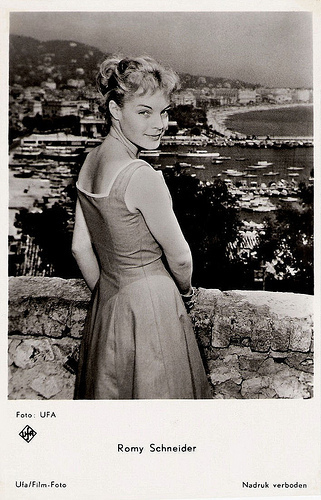
Dutch postcard by Gebr. Spanjersberg N.V., Rotterdam, no. 3651. Photo: Ufa, Berlin. Publicity still for Scampolo (1958).
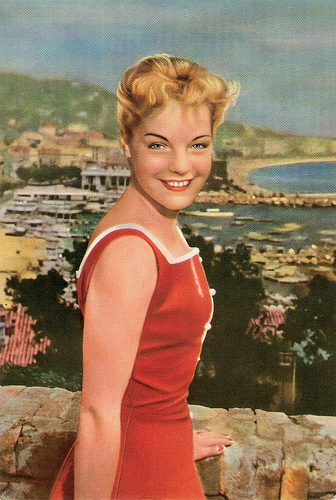
Dutch postcard by Gebr. Spanjersberg, no. 1014, mailed in 1958. Photo: Universum-Film Aktiengesellschaft (UFA), Berlin-Tempelhof.
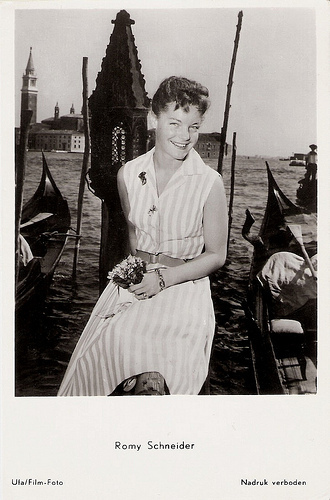
Dutch postcard by Gebr. Spanjersberg N.V., Rotterdam, no. 1040/858. Photo: Universum-Film Aktiengesellschaft (UFA), Berlin-Tempelhof.
Scampolo
In the German production Scampolo (Alfred Weidenmann, 1958), Romy starred as a young, poor orphan who lives on the Italian island Ischia. Scampolo works as a tourist guide and for a laundress (Elisabeth Flickenschildt). She falls in love with a handsome but poor architect ( Paul Hubschmid ) who hopes to win a design competition. Scampolo intercedes on his behalf with the minister ( Viktor de Kowa ) and helps him to make his dream come true.
Scampolo (translation: remnant) was loosely based on a play by Dario Niccodemi. It was not the first film adaptation. In 1917 there was already an Italian silent film directed by Giuseppe Sterni with Margot Pellegrinetti as Scampolo.
Silent film diva Carmen Boni played her also in a 1928 Italian production directed by Augusto Genina. This version has been recently rediscovered and restored by the Bologna cinematheque.
Four years later Hans Steinhoff made a sound version in Germany starring Dolly Haas , Scampolo, ein Kind der Straße/Scampolo a Child of the Streets (1932). This time Scampolo has nowhere to live in Berlin, and must sleep rough. Steinhoff also directed a French language version, Un peu d'amour/A Bit of Love (1932), starring Madeleine Ozeray .
In 1941 followed another Italian version, Scampolo (Nunzio Malasomma, 1941) with Lilia Silvi and in 1953 yet a new Italian adaptation Scampolo 53 (Girogio Bianchi, 1953) starring Maria Fiori. The 1958 version with Romy Schneider was the last film adaptation, till now.
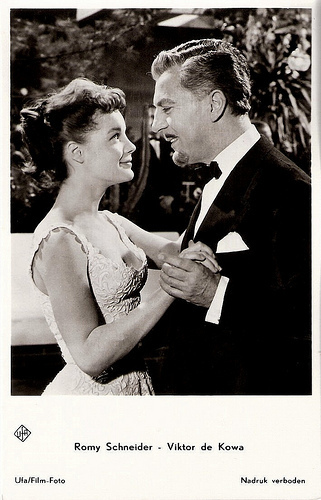
Romy Schneider and Viktor de Kowa . Dutch postcard by Gebr. Spanjersberg N.V., Rotterdam, no. 1108. Photo: UFA (Universum-Film Aktien-gesellschaft, Berlin-Tempelhof). Still from Scampolo (1958).
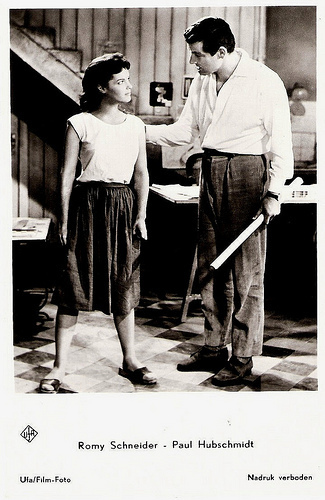
Romy Schneider and Paul Hubschmid . Dutch postcard by Gebr. Spanjersberg N.V., Rotterdam, no. 1118. Photo: UFA (Universum-Film Aktien-gesellschaft, Berlin-Tempelhof). Publicity still for Scampolo (Alfred Weidenmann, 1958).
Talented at multiple levels
Scampolo was only the second film young idol Romy Schneider made after the hugely popular Sissi trilogy.
The cast included well-known actors as Paul Hubschmid , Georg Thomalla , Eva Maria Meineke, Franca Parisi , Elisabeth Flickenschildt, Willy Millowitsch, Walter Rilla and Viktor de Kowa , but Schneider was the heart of the film.
Marcin Kukuczka at IMDb : " Romy Schneider is great! The fact that Scampolo was filmed just after the third part of Sissi is too significant not to be skipped. Romy was considered to fit best to 'royal roles' by a number of people. Partly, thanks to Scampolo, she proved that she was talented at multiple levels."
The comedy was shot on Ischia Island in Italy with wonderful cinematography by Bruno Mondi, who had also shot the Sissi films. Mondi had already started in the silent era as a camera assistant for Fritz Lang's Der Müde Tod (1921). During World War II, he worked with director Veit Harlan on the anti-Semitic propaganda film Jud Süß (1940). After the war, Mondi went on working at films without any problems and shot socialist-style re-education films in the Soviet zone like Wozzeck (Georg C. Klaren, 1947) and Rotation (Wolfgang Staudte, 1949).
StateofThings at IMDb : "Bruno Mondi is a luminous example for a brilliant and inventive cameraman and a frightening example for a perfect technician, not asking for the aim of his work."
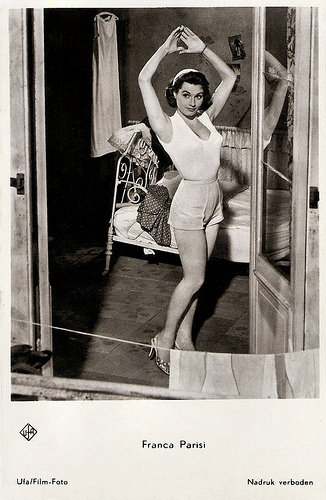
Franca Parisi . Dutch postcard by Gebr. Spanjersberg, Rotterdam (Dutch licency holder for Universum-Film Aktien-gesellschaft, Berlin-Tempelhof), no. 1086. Photo: Ufa/Film-Foto. Publicity still for Scampolo (Alfred Weidenmann, 1958).
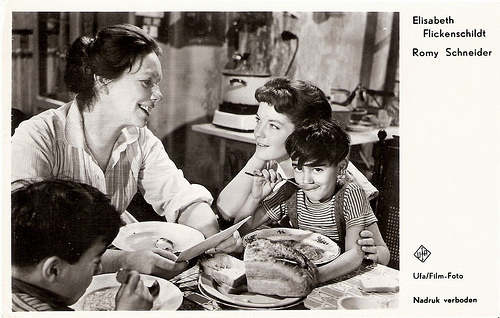
Elisabeth Flickenschildt and Romy Schneider . Dutch postcard by Gebr. Spanjersberg N.V., Rotterdam. Photo: Ufa/Film-Foto for Scampolo (Alfred Weidenmann, 1958).
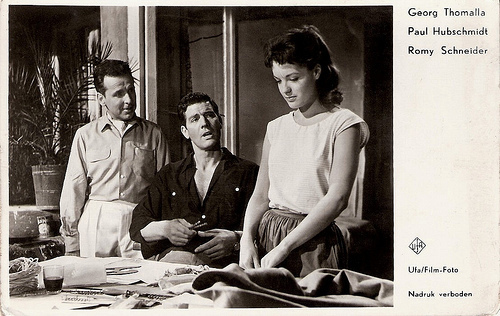
Paul Hubschmidt , Georg Thomalla and Romy Schneider . Dutch Postcard by Gebr. Spanjersberg N.V., Rotterdam. Photo: Ufa/Film-Foto for Scampolo (Alfred Weidenmann, 1958).
Source: James Travers (French Film Site), Filmreference.com, Wikipedia (English and German) and IMDb.

Dutch postcard by Gebr. Spanjersberg N.V., Rotterdam, no. 3651. Photo: Ufa, Berlin. Publicity still for Scampolo (1958).

Dutch postcard by Gebr. Spanjersberg, no. 1014, mailed in 1958. Photo: Universum-Film Aktiengesellschaft (UFA), Berlin-Tempelhof.

Dutch postcard by Gebr. Spanjersberg N.V., Rotterdam, no. 1040/858. Photo: Universum-Film Aktiengesellschaft (UFA), Berlin-Tempelhof.
Scampolo
In the German production Scampolo (Alfred Weidenmann, 1958), Romy starred as a young, poor orphan who lives on the Italian island Ischia. Scampolo works as a tourist guide and for a laundress (Elisabeth Flickenschildt). She falls in love with a handsome but poor architect ( Paul Hubschmid ) who hopes to win a design competition. Scampolo intercedes on his behalf with the minister ( Viktor de Kowa ) and helps him to make his dream come true.
Scampolo (translation: remnant) was loosely based on a play by Dario Niccodemi. It was not the first film adaptation. In 1917 there was already an Italian silent film directed by Giuseppe Sterni with Margot Pellegrinetti as Scampolo.
Silent film diva Carmen Boni played her also in a 1928 Italian production directed by Augusto Genina. This version has been recently rediscovered and restored by the Bologna cinematheque.
Four years later Hans Steinhoff made a sound version in Germany starring Dolly Haas , Scampolo, ein Kind der Straße/Scampolo a Child of the Streets (1932). This time Scampolo has nowhere to live in Berlin, and must sleep rough. Steinhoff also directed a French language version, Un peu d'amour/A Bit of Love (1932), starring Madeleine Ozeray .
In 1941 followed another Italian version, Scampolo (Nunzio Malasomma, 1941) with Lilia Silvi and in 1953 yet a new Italian adaptation Scampolo 53 (Girogio Bianchi, 1953) starring Maria Fiori. The 1958 version with Romy Schneider was the last film adaptation, till now.

Romy Schneider and Viktor de Kowa . Dutch postcard by Gebr. Spanjersberg N.V., Rotterdam, no. 1108. Photo: UFA (Universum-Film Aktien-gesellschaft, Berlin-Tempelhof). Still from Scampolo (1958).

Romy Schneider and Paul Hubschmid . Dutch postcard by Gebr. Spanjersberg N.V., Rotterdam, no. 1118. Photo: UFA (Universum-Film Aktien-gesellschaft, Berlin-Tempelhof). Publicity still for Scampolo (Alfred Weidenmann, 1958).
Talented at multiple levels
Scampolo was only the second film young idol Romy Schneider made after the hugely popular Sissi trilogy.
The cast included well-known actors as Paul Hubschmid , Georg Thomalla , Eva Maria Meineke, Franca Parisi , Elisabeth Flickenschildt, Willy Millowitsch, Walter Rilla and Viktor de Kowa , but Schneider was the heart of the film.
Marcin Kukuczka at IMDb : " Romy Schneider is great! The fact that Scampolo was filmed just after the third part of Sissi is too significant not to be skipped. Romy was considered to fit best to 'royal roles' by a number of people. Partly, thanks to Scampolo, she proved that she was talented at multiple levels."
The comedy was shot on Ischia Island in Italy with wonderful cinematography by Bruno Mondi, who had also shot the Sissi films. Mondi had already started in the silent era as a camera assistant for Fritz Lang's Der Müde Tod (1921). During World War II, he worked with director Veit Harlan on the anti-Semitic propaganda film Jud Süß (1940). After the war, Mondi went on working at films without any problems and shot socialist-style re-education films in the Soviet zone like Wozzeck (Georg C. Klaren, 1947) and Rotation (Wolfgang Staudte, 1949).
StateofThings at IMDb : "Bruno Mondi is a luminous example for a brilliant and inventive cameraman and a frightening example for a perfect technician, not asking for the aim of his work."

Franca Parisi . Dutch postcard by Gebr. Spanjersberg, Rotterdam (Dutch licency holder for Universum-Film Aktien-gesellschaft, Berlin-Tempelhof), no. 1086. Photo: Ufa/Film-Foto. Publicity still for Scampolo (Alfred Weidenmann, 1958).

Elisabeth Flickenschildt and Romy Schneider . Dutch postcard by Gebr. Spanjersberg N.V., Rotterdam. Photo: Ufa/Film-Foto for Scampolo (Alfred Weidenmann, 1958).

Paul Hubschmidt , Georg Thomalla and Romy Schneider . Dutch Postcard by Gebr. Spanjersberg N.V., Rotterdam. Photo: Ufa/Film-Foto for Scampolo (Alfred Weidenmann, 1958).
Source: James Travers (French Film Site), Filmreference.com, Wikipedia (English and German) and IMDb.
Published on April 10, 2015 22:00
April 9, 2015
Elisabeth Wiener
Elisabeth Wiener (1946) is a French actress, singer, songwriter and performer, who appeared in several French and Italian films of the 1960s and 1970s.
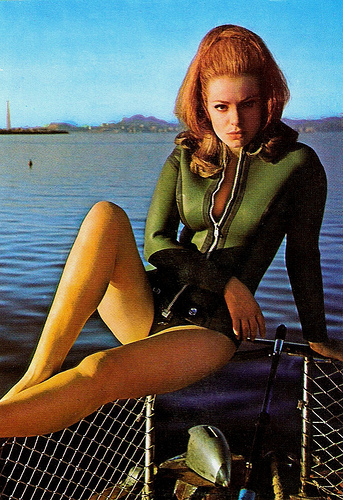
Romanian postcard by Casa Filmului Acin.
Sensational Erotic and Psychological Thriller
Elisabeth (or Élizabeth) Wiener was born in Paris, France in 1946 as the daughter of composer Jean Wiener and film editor Suzanne De Troeye. She began her acting career at the age of 15 and also practiced classical singing and piano.
She made her film debut as Frederique in the independent comedy Dragées au poivre/Sweet and Sour (Jacques Baratier) with Guy Bedos. Soon followed L'Année du bac/Graduation Year (Maurice Delbez, José-André Lacour, 1964) with Jean Desailly. She also had a small part in the American war drama Behold a Pale Horse (Fred Zinnemann, 1964) starring Gregory Peck, which was filmed in France.
At 16 and a half she married. Two years later, she played Coralie, a young stage actress, in the TV mini-series Illusions perdues/Lost Illusions (Maurice Cazeneuve, 1966), based on a novel by Honoré de Balzac. At the time she appeared in many French TV films and series, including the popular mini-series Jacquou le Croquant/Jacquou the crunch (Stellio Lorenzi, 1969).
In the cinema she participated in the crime film Johnny Banco (Yves Allégret, 1967), a disastrous euro pudding with both funds and stars (including Horst Buchholz and Sylva Koscina ) from three European countries.
More interesting was the sensational erotic and psychological thriller La Prisonnière/The Female Prisoner (Henri-Georges Clouzot, 1968) in which she starred as the emotional prisoner of voyeur Laurent Terzieff . It was the last film of Henri-Georges Clouzot, the French Alfred Hitchcock.
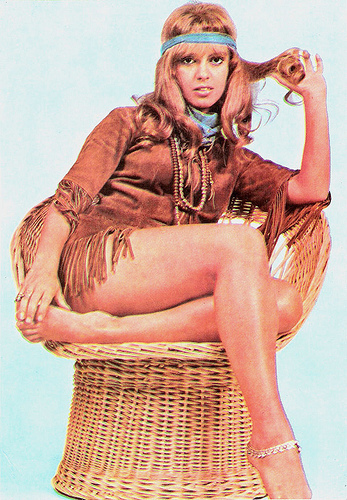
Romanian postcard by Casa Filmului Acin.
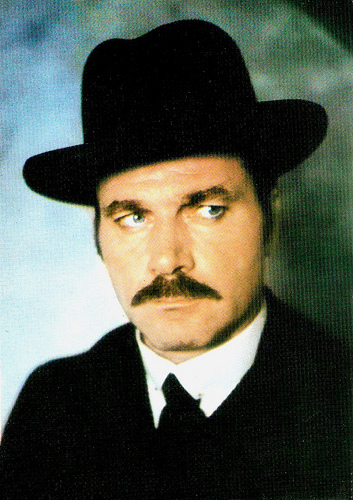
Franco Nero . Romanian postcard by Casa Filmului Acin.
A Mythical War Between Goddesses
During the early 1970s, Elisabeth Wiener acted in such films as On est toujours trop bon avec les femmes/One Is Always Too Good to Women (Michel Boisrond, 1971), Le moine/The Monk (Adonis Kyrou, 1972) with Franco Nero , the comedy Trop jolies pour être honnêtes/Too Pretty to Be Honest (Richard Balducci, 1972) with Jane Birkin , and La Jeune Fille assassinée/The Assassinated Young Girl (Roger Vadim, 1974).
One of her most interesting films was Duelle/Duel (Jacques Rivette, 1976) starring Juliet Berto and Bulle Ogier. It was meant to be as the first of four different films directed by Jacques Rivette with a running sub-plot involving a mythical war between goddesses of the Sun and the Moon, but till now Rivette has made only three parts.
In Italy, Wiener appeared in Al di là del bene e del male/Beyond Good and Evil (Liliana Cavani, 1977) starring Dominique Sanda , and the comedy Bianco, rosso e Verdone/White, red and Verdone (Carlo Verdone, 1981).
Wiener participated in musical performances by Michel Polnareff and Jacques Higelin. Most notably, she collaborated on their album Champagne pour tout le monde (Champagne for everyone). She is also interested in jazz as well as in contemporary and ethnic music. She joined such alternative rock groups as Phoenix before she started a solo career. She wrote for many singers and also composed several film scores. In 1992 she founded the female band Castafiore Bazooka.
Her most recent screen appearance was in the TV series Les Misérables (Josée Dayan, 2000) starring Gérard Depardieu . Elisabeth Wiener currently works as a voice actor and dubs such American stars as Jamie Lee Curtis, Glenn Close, Mia Farrow, Meryl Streep and Lauren Holly in the popular crime series NCIS (2005-2008). And she performs and records as La Beth and with her band Castafiore Bazooka.
Original French trailer of La Prisonnière/The Female Prisoner (1968). Source: Vincent Domaslaw (YouTube).
Elisabeth Wiener sings Vie a vies (1982). Source: TchikiSteph (YouTube).
Sources: ElisabethWiener.com (French), Wikipedia (French and English) and .

Romanian postcard by Casa Filmului Acin.
Sensational Erotic and Psychological Thriller
Elisabeth (or Élizabeth) Wiener was born in Paris, France in 1946 as the daughter of composer Jean Wiener and film editor Suzanne De Troeye. She began her acting career at the age of 15 and also practiced classical singing and piano.
She made her film debut as Frederique in the independent comedy Dragées au poivre/Sweet and Sour (Jacques Baratier) with Guy Bedos. Soon followed L'Année du bac/Graduation Year (Maurice Delbez, José-André Lacour, 1964) with Jean Desailly. She also had a small part in the American war drama Behold a Pale Horse (Fred Zinnemann, 1964) starring Gregory Peck, which was filmed in France.
At 16 and a half she married. Two years later, she played Coralie, a young stage actress, in the TV mini-series Illusions perdues/Lost Illusions (Maurice Cazeneuve, 1966), based on a novel by Honoré de Balzac. At the time she appeared in many French TV films and series, including the popular mini-series Jacquou le Croquant/Jacquou the crunch (Stellio Lorenzi, 1969).
In the cinema she participated in the crime film Johnny Banco (Yves Allégret, 1967), a disastrous euro pudding with both funds and stars (including Horst Buchholz and Sylva Koscina ) from three European countries.
More interesting was the sensational erotic and psychological thriller La Prisonnière/The Female Prisoner (Henri-Georges Clouzot, 1968) in which she starred as the emotional prisoner of voyeur Laurent Terzieff . It was the last film of Henri-Georges Clouzot, the French Alfred Hitchcock.

Romanian postcard by Casa Filmului Acin.

Franco Nero . Romanian postcard by Casa Filmului Acin.
A Mythical War Between Goddesses
During the early 1970s, Elisabeth Wiener acted in such films as On est toujours trop bon avec les femmes/One Is Always Too Good to Women (Michel Boisrond, 1971), Le moine/The Monk (Adonis Kyrou, 1972) with Franco Nero , the comedy Trop jolies pour être honnêtes/Too Pretty to Be Honest (Richard Balducci, 1972) with Jane Birkin , and La Jeune Fille assassinée/The Assassinated Young Girl (Roger Vadim, 1974).
One of her most interesting films was Duelle/Duel (Jacques Rivette, 1976) starring Juliet Berto and Bulle Ogier. It was meant to be as the first of four different films directed by Jacques Rivette with a running sub-plot involving a mythical war between goddesses of the Sun and the Moon, but till now Rivette has made only three parts.
In Italy, Wiener appeared in Al di là del bene e del male/Beyond Good and Evil (Liliana Cavani, 1977) starring Dominique Sanda , and the comedy Bianco, rosso e Verdone/White, red and Verdone (Carlo Verdone, 1981).
Wiener participated in musical performances by Michel Polnareff and Jacques Higelin. Most notably, she collaborated on their album Champagne pour tout le monde (Champagne for everyone). She is also interested in jazz as well as in contemporary and ethnic music. She joined such alternative rock groups as Phoenix before she started a solo career. She wrote for many singers and also composed several film scores. In 1992 she founded the female band Castafiore Bazooka.
Her most recent screen appearance was in the TV series Les Misérables (Josée Dayan, 2000) starring Gérard Depardieu . Elisabeth Wiener currently works as a voice actor and dubs such American stars as Jamie Lee Curtis, Glenn Close, Mia Farrow, Meryl Streep and Lauren Holly in the popular crime series NCIS (2005-2008). And she performs and records as La Beth and with her band Castafiore Bazooka.
Original French trailer of La Prisonnière/The Female Prisoner (1968). Source: Vincent Domaslaw (YouTube).
Elisabeth Wiener sings Vie a vies (1982). Source: TchikiSteph (YouTube).
Sources: ElisabethWiener.com (French), Wikipedia (French and English) and .
Published on April 09, 2015 22:00
April 8, 2015
Greer Garson
British-born actress Greer Garson (1904-1996) was a very popular Hollywood star during World War II. She epitomized a noble, wise and courageous wife in sleek and sentimental films, often with Walter Pidgeon as her co-star. As one of MGM's major stars of the 1940s, Garson received seven Academy Award nominations. She won the Oscar for Mrs. Miniver (1942), in which she personified the spirit and virtue of a British homemaker in wartime.
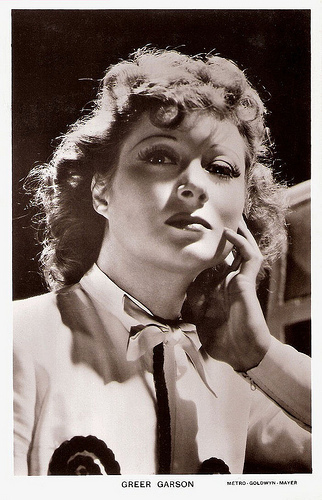
British postcard in the Picturegoer series, London, no. W 95. Photo: Metro Goldwyn Mayer (MGM).
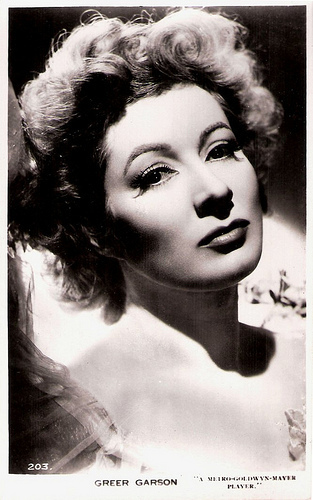
British postcard in the Real Photograph series, no. 203. Photo: MGM.
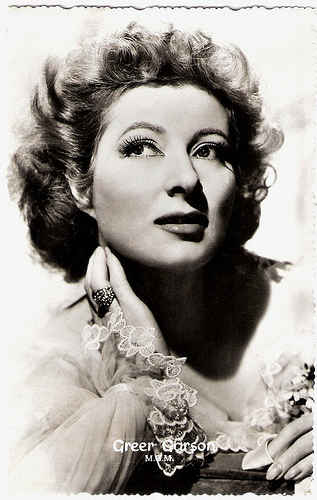
Dutch postcard by Weenenk & Snel, Baarn, no. 1155. Photo: MGM.
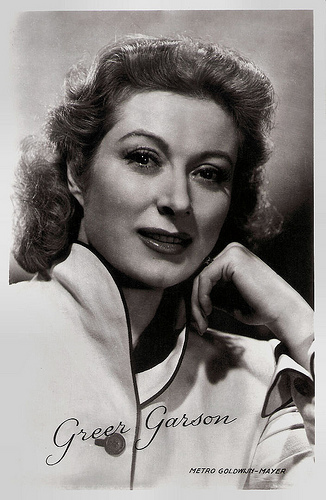
Dutch postcard, no. 3016. Photo: Metro Goldwyn Mayer (MGM).
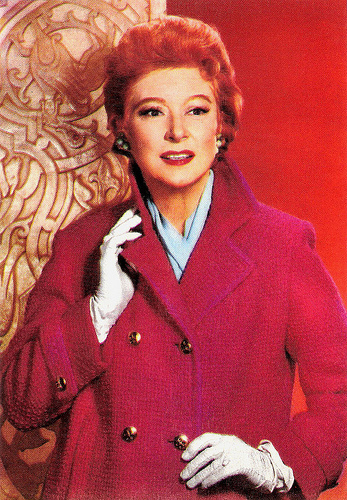
Italian postcard. Photo: Metro Goldwyn Mayer (MGM). Publicity still for The Singing Nun/Dominique (Henry Koster, 1966).
Elegant Manner and Flaming Red Hair
Greer Garson was born Eileen Evelyn Greer Garson in Manor Park, Essex (now Greater London), England in 1904. Garson herself always claimed that she was born in Ireland in 1908. She was the only child of clerk George Garson and his Irish wife, Nancy Sophia Greer. Her father died during an appendectomy when Greer was only two. Her mother provided a living for them by managing townhouses that her husband had owned.
From 1921 on, Greer was educated at the University of London, earning a Bachelor's degree in 1926. She had intended to become a teacher, but instead began working in a research library for an advertising agency, and appeared in local theatrical productions whenever she could.
In 1931, she could start her professional stage career at the Birmingham Repertory Company and she quit her job at the ad agency. She made her first stage appearance as an American Jewish tenement girl in Street Scene. In 1934 she appeared in the short film Inasmuch... (Alec Saville, 1934) with Donald Wolfit. That same year her London stage debut came in The Tempest.
Her role in the play The Golden Arror with Laurence Olivier proved to be her breakthrough. She was suddenly very popular throughout London and offers to headline in plays and musicals poured in. She acted in a variety of plays, ranging from Shakespeare to costume dramas, but none of them were huge hits. She also appeared on BBC television during its earliest years, most notably starring in a thirty-minute production of an excerpt of Twelfth Night (1937), with Dorothy Black.
In 1937, while performing in the play Old Music, she was discovered by MGM mogul Louis B. Mayer. He was in London looking for new talent, and was entranced by her elegant manner and flaming red hair. Garson signed a seven year contract with MGM in late 1937, but did not start to work until late 1938.
When she finally made her first Hollywood film, Garson was already in her mid thirties. Goodbye Mr. Chips (Sam Wood, 1939) was based on James Hilton's short story about a beloved school master. The film was made in England and had a British cast including Robert Donat as Mr. Chips. For the role of his captivating young wife Garson received her first Oscar nomination, but lost to Vivien Leigh for Gone with the Wind (Victor Fleming, 1939).
However, Louis B. Mayer knew he had a star and she was arriving at a great time. Both of MGM's most prestigious actresses, Greta Garbo and Norma Shearer were retiring. Greer was next cast in a fluffy comedy called Remember? (Norman Z. MacLeod, 1939) while Mayer searched for quality roles for his new leading lady.
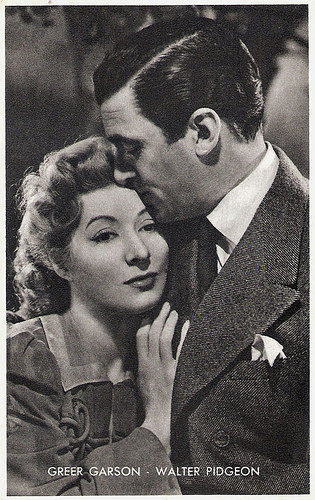
Belgian collectors card by Kwatta, Bois d'Haine, no. C. 167. Photo: Metro Goldwyn Mayer. Publicity still for Blossoms in the Dust (Mervyn Leroy, 1941).
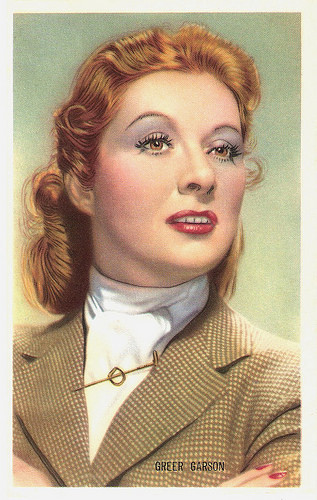
Belgian collectors card by Kwatta, Bois d'Haine, no. C. 203. Photo: Metro Goldwyn Mayer (M.G.M.).
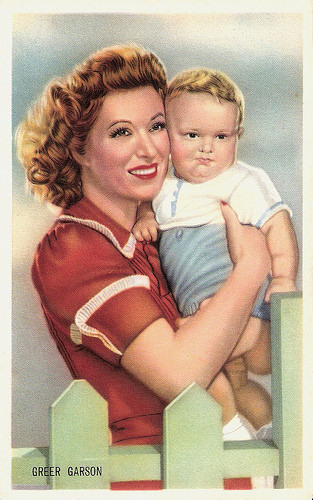
Belgian collectors card by Kwatta, Bois d'Haine, no. C 208. Photo: MGM. Publicity still for Blossoms in the Dust (Mervyn LeRoy, 1941) .
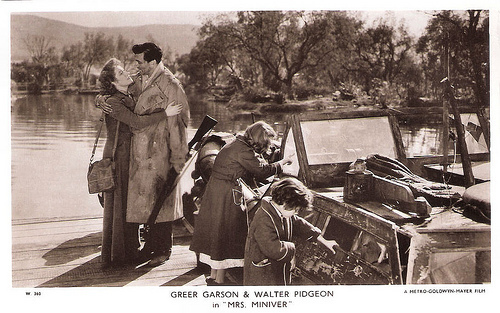
British postcard in the Picturegoer Series, London, no. W 360. Photo: MGM. Publicity still for Mrs. Miniver (1942) with Walter Pidgeon.
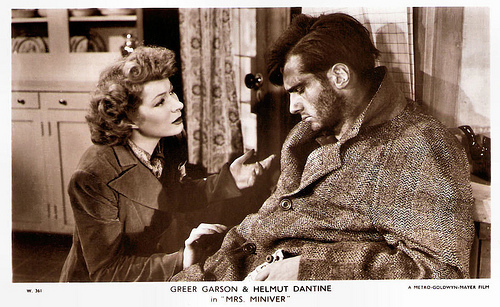
British postcard in the Picturegoer Series, London, no. W 361. Photo: MGM. Publicity still for Mrs. Miniver (1942) with Helmut Dantine.
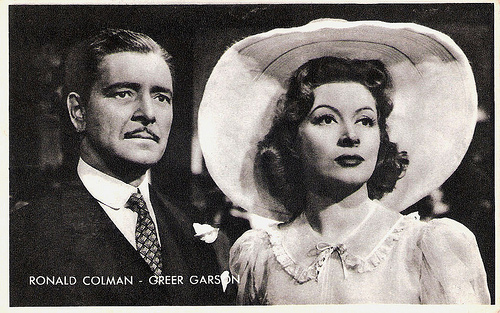
Belgian collector's card by Kwatta, Bois-D'Haine, Serie C, no. C. 170. Photo: M.G.M. Publicity still for Random Harvest (1942).
One of the 10 Most Popular Hollywood Stars
The next year Greer Garson again received critical acclaim for her role as Elizabeth Bennet in Pride and Prejudice (Robert Z. Leonard, 1940) with Laurence Olivier as Darcy. She quickly became one of the 10 most popular Hollywood stars. She starred with Joan Crawford in When Ladies Meet (Robert Z. Leonard, 1941).
That same year she became a major star with the sentimental drama Blossoms in the Dust (Mervyn Leroy, 1941), which was based on the life of Edna Gladney, who founded an orphanage in Fort Worth, Texas. It was filmed in Technicolor and audiences had their first chance to see Greer's gorgeous red hair. Walter Pidgeon was cast opposite her and their pairing would be repeated numerous times in the future. At AllMovie , Hal Erickson writes: “Greer Garson is dignity and integrity personified in the role of the real-life Edna Gladney.” The film brought her the first of five consecutive Best Actress Oscar nominations.
Garson won the Academy Award for Best Actress in 1942 for her role as a strong British wife and mother in the middle of World War II in the morale-booster Mrs. Miniver (William Wyler, 1942). Hal Erickson reviews: “As Academy Award-winning films go, Mrs. Miniver has not weathered the years all that well. This prettified, idealized view of the upper-class British home front during World War II sometimes seems over-calculated and contrived when seen today. In particular, Greer Garson's Oscar-winning performance in the title role often comes off as artificial, especially when she nobly tends her rose garden while her stalwart husband (Walter Pidgeon) participates in the evacuation at Dunkirk. However, even if the film has lost a good portion of its ability to move and inspire audiences, it is easy to see why it was so popular in 1942-and why Winston Churchill was moved to comment that its propaganda value was worth a dozen battleships. Everyone in the audience-even English audiences, closer to the events depicted in the film than American filmgoers-liked to believe that he or she was capable of behaving with as much grace under pressure as the Miniver family.”
Garson was also nominated for Madame Curie (Mervyn Leroy, 1943), Mrs. Parkington (Tay Garnett, 1944), and The Valley of Decision (Tay Garnett, 1945). Garson was partnered with Clark Gable, after his return from war service, in Adventure (Victor Fleming, 1945). The film was advertised with the catch-phrase "Gable's back and Garson's got him!" Gable argued for "He put the Arson in Garson", and she countered "She Put the Able in Gable!" Thereafter, the safer catchphrase was selected.
The war ended and the public's taste and the studio system in Hollywood began to change. Louis B. Mayer would leave MGM in a few years and Dore Schary would take his place. The elaborate expense once lavished on prestigious MGM films would be curtailed and more attention would be given to films dealing with realism and social issues. ‘Women's films’, the type of movies that Greer Garson excelled in, would no longer be a top priority.
Her downward spiral stopped with the comedy Julia Misbehaves (Jack Conway, 1948) and the hit That Forsyte Woman (Compton Bennett, 1949). The next year she reprised her role as Kay Miniver in The Miniver Story (H.C. Potter, 1950). Unfortunately it didn't fare too well, but Garson remained a prominent film star until the mid-1950s.
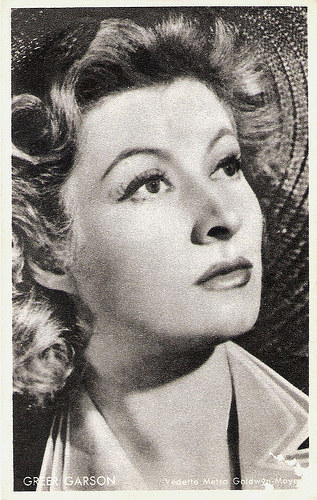
Belgian collectors card by Kwatta, Bois d'Haine, no. C. 2. Photo: Metro Goldwyn Mayer.
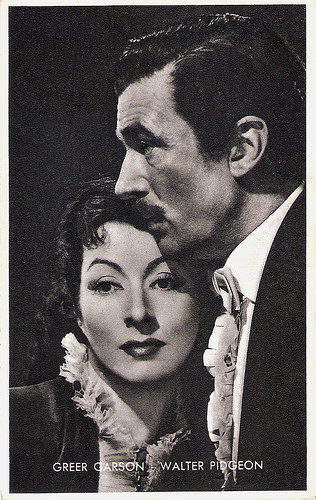
Belgian collectors card by Kwatta, Bois d'Haine, no. C. 167. Photo: Metro Goldwyn Mayer. Publicity still for Mrs. Parkington (Tay Garnett, 1944) with Walter Pidgeon.
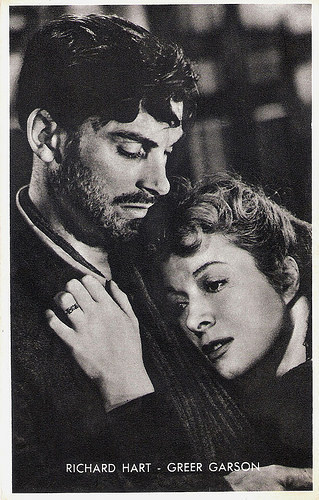
Belgian collectors card by Kwatta, Bois d'Haine, no. C. 195. Photo: Metro Goldwyn Mayer. Publicity still for Desire Me (1947) with Richard Hart.
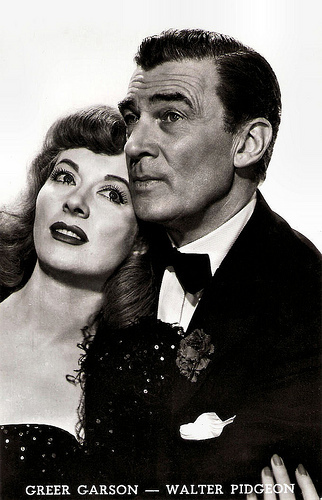
French postcard, no. 850. Photo: Metro Goldwyn Mayer (MGM).
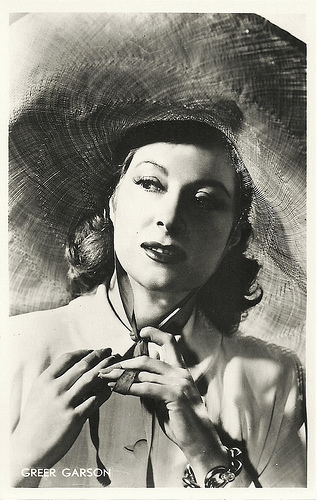
Dutch postcard by S.& v.H.A. Photo: M.P.E.A.
Her Seventh and Final Oscar Nomination
In 1951, Greer Garson became a naturalized citizen of the United States. Her films included The Law and the Lady (Edwin H. Knopf, 1951) and Julius Caesar (Joseph L. Mankiewicz, 1953) starring Marlon Brando. She made only a few films after her MGM contract expired in 1954.
She returned to the stage in late 1957 in the triumphant Auntie Mame on Broadway and earned rave reviews. She had replaced Rosalind Russell, who had gone to Hollywood to make the film version.
In 1960, Garson received her seventh and final Oscar nomination for Sunrise at Campobello (Vincent J. Donehue, 1960), in which she portrayed Eleanor Roosevelt astonishingly accurate opposite Ralph Bellamy as Franklin Roosevelt. This time she lost the Oscar to Elizabeth Taylor for Butterfield 8 (Daniel Mann, 1960).
In The Singing Nun (Henry Koster, 1966) she played the Mother Prioress opposite Debbie Reynolds as the title character. Garson's last film was Disney's The Happiest Millionaire (Norman Tokar, 1967), but she continued to make infrequent television appearances. She narrated the children's television special The Little Drummer Boy (Jules Bass, Arthur Rankin Jr., 1968), which went on to become a classic children's Christmas television program, broadcasted annually for many years.
Greer Garson was married three times. Her first marriage was to Edward Alec Abbot Snelson, a British civil servant who became a noted judge and expert in Indian and Pakistani affairs. The actual marriage in 1933 reportedly lasted only the honeymoon, but was not formally dissolved until 1943. Her second husband, whom she married in 1943, was Richard Ney, the 27-year-old actor who played her son in Mrs. Miniver (1942). They divorced in 1947. Garson claimed that Ney called her a ‘has-been’ and belittled her age. She also testified that he had physically abused her. Ney eventually became a respected stock-market analyst and financial consultant.
That same year, she married a millionaire Texas oilman and horse breeder, E. E. ‘Buddy’ Fogelson. In 1967, the couple retired to their ‘Forked Lightning Ranch’ in New Mexico. They purchased the U.S. Hall of Fame champion Thoroughbred Ack Ack from the estate of Harry F. Guggenheim in 1971, and were highly successful as breeders. They also maintained a home in Dallas, Texas, where Garson funded the Greer Garson Theater facility at Southern Methodist University. In 1975, she appeared at this theatre in The Madwoman of Challiot. It would be her final stage performance.
Garson continued to do television work, appearing in the TV series Little Women (Gordon Hessler, 1978) and The Love Boat (Richard A. Wells, 1982). In 1982, she turned down producer Aaron Spelling's offer of a part in the hit soap Dynasty (1981-1989), to play the mother of Joan Collins 's Alexis. She had to give up even these performances in the early 1980s due to chronic heart problems. In 1996 Greer Garson died from heart failure in Dallas, Texas, USA, at the age of 90.
Greer Garson meets Walter Pidgeon for the first time in Blossoms in the Dust (1941). Source: Edatola (YouTube).
Scene from That Forsyte Woman (1949) with Robert Young. Source: Edatola (YouTube).
Sources: (IMDb), Peter B. Flint (The New York Times), Hal Erickson (AllMovie), Wikipedia and .

British postcard in the Picturegoer series, London, no. W 95. Photo: Metro Goldwyn Mayer (MGM).

British postcard in the Real Photograph series, no. 203. Photo: MGM.

Dutch postcard by Weenenk & Snel, Baarn, no. 1155. Photo: MGM.

Dutch postcard, no. 3016. Photo: Metro Goldwyn Mayer (MGM).

Italian postcard. Photo: Metro Goldwyn Mayer (MGM). Publicity still for The Singing Nun/Dominique (Henry Koster, 1966).
Elegant Manner and Flaming Red Hair
Greer Garson was born Eileen Evelyn Greer Garson in Manor Park, Essex (now Greater London), England in 1904. Garson herself always claimed that she was born in Ireland in 1908. She was the only child of clerk George Garson and his Irish wife, Nancy Sophia Greer. Her father died during an appendectomy when Greer was only two. Her mother provided a living for them by managing townhouses that her husband had owned.
From 1921 on, Greer was educated at the University of London, earning a Bachelor's degree in 1926. She had intended to become a teacher, but instead began working in a research library for an advertising agency, and appeared in local theatrical productions whenever she could.
In 1931, she could start her professional stage career at the Birmingham Repertory Company and she quit her job at the ad agency. She made her first stage appearance as an American Jewish tenement girl in Street Scene. In 1934 she appeared in the short film Inasmuch... (Alec Saville, 1934) with Donald Wolfit. That same year her London stage debut came in The Tempest.
Her role in the play The Golden Arror with Laurence Olivier proved to be her breakthrough. She was suddenly very popular throughout London and offers to headline in plays and musicals poured in. She acted in a variety of plays, ranging from Shakespeare to costume dramas, but none of them were huge hits. She also appeared on BBC television during its earliest years, most notably starring in a thirty-minute production of an excerpt of Twelfth Night (1937), with Dorothy Black.
In 1937, while performing in the play Old Music, she was discovered by MGM mogul Louis B. Mayer. He was in London looking for new talent, and was entranced by her elegant manner and flaming red hair. Garson signed a seven year contract with MGM in late 1937, but did not start to work until late 1938.
When she finally made her first Hollywood film, Garson was already in her mid thirties. Goodbye Mr. Chips (Sam Wood, 1939) was based on James Hilton's short story about a beloved school master. The film was made in England and had a British cast including Robert Donat as Mr. Chips. For the role of his captivating young wife Garson received her first Oscar nomination, but lost to Vivien Leigh for Gone with the Wind (Victor Fleming, 1939).
However, Louis B. Mayer knew he had a star and she was arriving at a great time. Both of MGM's most prestigious actresses, Greta Garbo and Norma Shearer were retiring. Greer was next cast in a fluffy comedy called Remember? (Norman Z. MacLeod, 1939) while Mayer searched for quality roles for his new leading lady.

Belgian collectors card by Kwatta, Bois d'Haine, no. C. 167. Photo: Metro Goldwyn Mayer. Publicity still for Blossoms in the Dust (Mervyn Leroy, 1941).

Belgian collectors card by Kwatta, Bois d'Haine, no. C. 203. Photo: Metro Goldwyn Mayer (M.G.M.).

Belgian collectors card by Kwatta, Bois d'Haine, no. C 208. Photo: MGM. Publicity still for Blossoms in the Dust (Mervyn LeRoy, 1941) .

British postcard in the Picturegoer Series, London, no. W 360. Photo: MGM. Publicity still for Mrs. Miniver (1942) with Walter Pidgeon.

British postcard in the Picturegoer Series, London, no. W 361. Photo: MGM. Publicity still for Mrs. Miniver (1942) with Helmut Dantine.

Belgian collector's card by Kwatta, Bois-D'Haine, Serie C, no. C. 170. Photo: M.G.M. Publicity still for Random Harvest (1942).
One of the 10 Most Popular Hollywood Stars
The next year Greer Garson again received critical acclaim for her role as Elizabeth Bennet in Pride and Prejudice (Robert Z. Leonard, 1940) with Laurence Olivier as Darcy. She quickly became one of the 10 most popular Hollywood stars. She starred with Joan Crawford in When Ladies Meet (Robert Z. Leonard, 1941).
That same year she became a major star with the sentimental drama Blossoms in the Dust (Mervyn Leroy, 1941), which was based on the life of Edna Gladney, who founded an orphanage in Fort Worth, Texas. It was filmed in Technicolor and audiences had their first chance to see Greer's gorgeous red hair. Walter Pidgeon was cast opposite her and their pairing would be repeated numerous times in the future. At AllMovie , Hal Erickson writes: “Greer Garson is dignity and integrity personified in the role of the real-life Edna Gladney.” The film brought her the first of five consecutive Best Actress Oscar nominations.
Garson won the Academy Award for Best Actress in 1942 for her role as a strong British wife and mother in the middle of World War II in the morale-booster Mrs. Miniver (William Wyler, 1942). Hal Erickson reviews: “As Academy Award-winning films go, Mrs. Miniver has not weathered the years all that well. This prettified, idealized view of the upper-class British home front during World War II sometimes seems over-calculated and contrived when seen today. In particular, Greer Garson's Oscar-winning performance in the title role often comes off as artificial, especially when she nobly tends her rose garden while her stalwart husband (Walter Pidgeon) participates in the evacuation at Dunkirk. However, even if the film has lost a good portion of its ability to move and inspire audiences, it is easy to see why it was so popular in 1942-and why Winston Churchill was moved to comment that its propaganda value was worth a dozen battleships. Everyone in the audience-even English audiences, closer to the events depicted in the film than American filmgoers-liked to believe that he or she was capable of behaving with as much grace under pressure as the Miniver family.”
Garson was also nominated for Madame Curie (Mervyn Leroy, 1943), Mrs. Parkington (Tay Garnett, 1944), and The Valley of Decision (Tay Garnett, 1945). Garson was partnered with Clark Gable, after his return from war service, in Adventure (Victor Fleming, 1945). The film was advertised with the catch-phrase "Gable's back and Garson's got him!" Gable argued for "He put the Arson in Garson", and she countered "She Put the Able in Gable!" Thereafter, the safer catchphrase was selected.
The war ended and the public's taste and the studio system in Hollywood began to change. Louis B. Mayer would leave MGM in a few years and Dore Schary would take his place. The elaborate expense once lavished on prestigious MGM films would be curtailed and more attention would be given to films dealing with realism and social issues. ‘Women's films’, the type of movies that Greer Garson excelled in, would no longer be a top priority.
Her downward spiral stopped with the comedy Julia Misbehaves (Jack Conway, 1948) and the hit That Forsyte Woman (Compton Bennett, 1949). The next year she reprised her role as Kay Miniver in The Miniver Story (H.C. Potter, 1950). Unfortunately it didn't fare too well, but Garson remained a prominent film star until the mid-1950s.

Belgian collectors card by Kwatta, Bois d'Haine, no. C. 2. Photo: Metro Goldwyn Mayer.

Belgian collectors card by Kwatta, Bois d'Haine, no. C. 167. Photo: Metro Goldwyn Mayer. Publicity still for Mrs. Parkington (Tay Garnett, 1944) with Walter Pidgeon.

Belgian collectors card by Kwatta, Bois d'Haine, no. C. 195. Photo: Metro Goldwyn Mayer. Publicity still for Desire Me (1947) with Richard Hart.

French postcard, no. 850. Photo: Metro Goldwyn Mayer (MGM).

Dutch postcard by S.& v.H.A. Photo: M.P.E.A.
Her Seventh and Final Oscar Nomination
In 1951, Greer Garson became a naturalized citizen of the United States. Her films included The Law and the Lady (Edwin H. Knopf, 1951) and Julius Caesar (Joseph L. Mankiewicz, 1953) starring Marlon Brando. She made only a few films after her MGM contract expired in 1954.
She returned to the stage in late 1957 in the triumphant Auntie Mame on Broadway and earned rave reviews. She had replaced Rosalind Russell, who had gone to Hollywood to make the film version.
In 1960, Garson received her seventh and final Oscar nomination for Sunrise at Campobello (Vincent J. Donehue, 1960), in which she portrayed Eleanor Roosevelt astonishingly accurate opposite Ralph Bellamy as Franklin Roosevelt. This time she lost the Oscar to Elizabeth Taylor for Butterfield 8 (Daniel Mann, 1960).
In The Singing Nun (Henry Koster, 1966) she played the Mother Prioress opposite Debbie Reynolds as the title character. Garson's last film was Disney's The Happiest Millionaire (Norman Tokar, 1967), but she continued to make infrequent television appearances. She narrated the children's television special The Little Drummer Boy (Jules Bass, Arthur Rankin Jr., 1968), which went on to become a classic children's Christmas television program, broadcasted annually for many years.
Greer Garson was married three times. Her first marriage was to Edward Alec Abbot Snelson, a British civil servant who became a noted judge and expert in Indian and Pakistani affairs. The actual marriage in 1933 reportedly lasted only the honeymoon, but was not formally dissolved until 1943. Her second husband, whom she married in 1943, was Richard Ney, the 27-year-old actor who played her son in Mrs. Miniver (1942). They divorced in 1947. Garson claimed that Ney called her a ‘has-been’ and belittled her age. She also testified that he had physically abused her. Ney eventually became a respected stock-market analyst and financial consultant.
That same year, she married a millionaire Texas oilman and horse breeder, E. E. ‘Buddy’ Fogelson. In 1967, the couple retired to their ‘Forked Lightning Ranch’ in New Mexico. They purchased the U.S. Hall of Fame champion Thoroughbred Ack Ack from the estate of Harry F. Guggenheim in 1971, and were highly successful as breeders. They also maintained a home in Dallas, Texas, where Garson funded the Greer Garson Theater facility at Southern Methodist University. In 1975, she appeared at this theatre in The Madwoman of Challiot. It would be her final stage performance.
Garson continued to do television work, appearing in the TV series Little Women (Gordon Hessler, 1978) and The Love Boat (Richard A. Wells, 1982). In 1982, she turned down producer Aaron Spelling's offer of a part in the hit soap Dynasty (1981-1989), to play the mother of Joan Collins 's Alexis. She had to give up even these performances in the early 1980s due to chronic heart problems. In 1996 Greer Garson died from heart failure in Dallas, Texas, USA, at the age of 90.
Greer Garson meets Walter Pidgeon for the first time in Blossoms in the Dust (1941). Source: Edatola (YouTube).
Scene from That Forsyte Woman (1949) with Robert Young. Source: Edatola (YouTube).
Sources: (IMDb), Peter B. Flint (The New York Times), Hal Erickson (AllMovie), Wikipedia and .
Published on April 08, 2015 22:00
April 7, 2015
Cinémagazine-Edition
Cinémagazine-Edition was just a small publishing company located in Paris, France. But the publisher had a good reputation and the quality of its sepia star postcards from the 1920s and early 1930s are still mesmerizing.
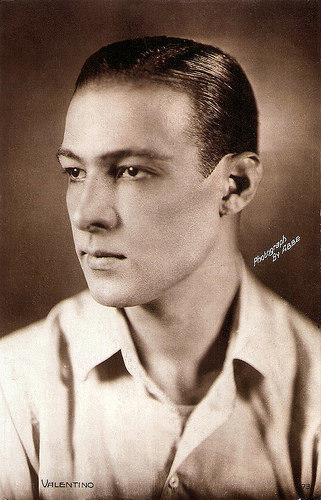
Rudolph Valentino. French postcard by Cinémagazine-Edition, Paris. Photo: James Abbe.
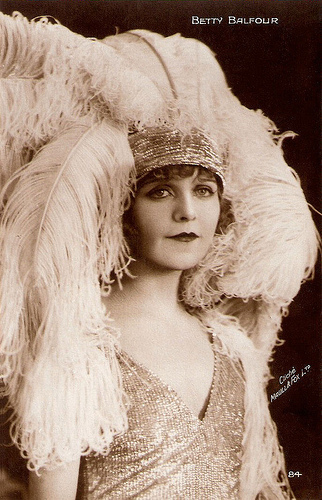
Betty Balfour. French postcard by Cinémagazine Edition, no. 84. Photo: Maull & Fox.
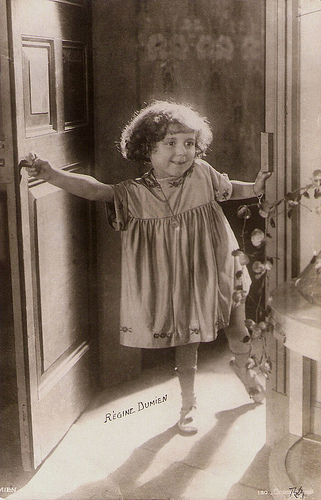
Régine Dumien . French postcard by Cinémagazine-Edition, no. 130.
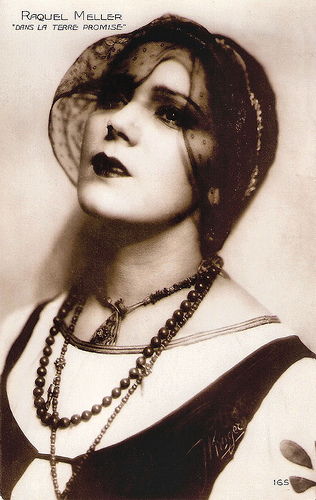
Raquel Meller. French postcard by Cinémagazine-Edition, Paris, no. 165. Photo: J. Kruger.
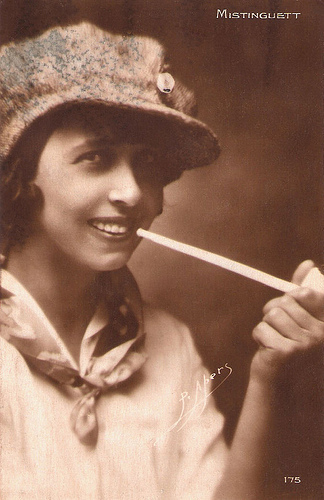
Mistinguett . French postcard by Cinémagazine-Edition, Paris, no. 175. Photo: P. Apers.
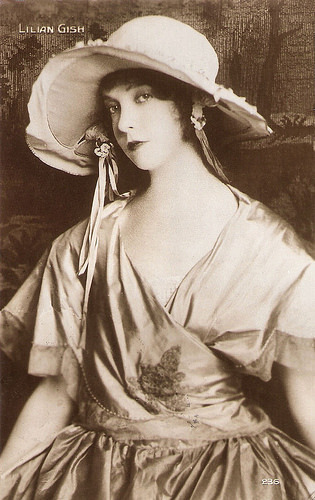
Lilian Gish. French postcard by Cinémagazine-Edition, Paris, no. 236.
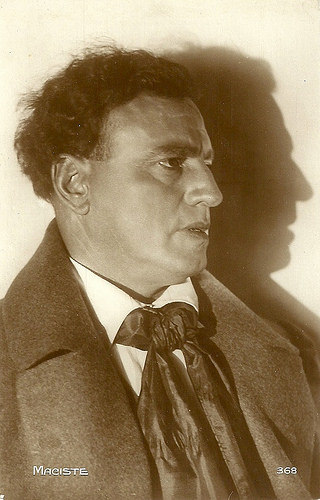
Maciste. French postcard by Editions Cinémagazine, no. 368. Bartolomeo Pagano aka Maciste in Maciste all'inferno (Guido Brignone, 1926).
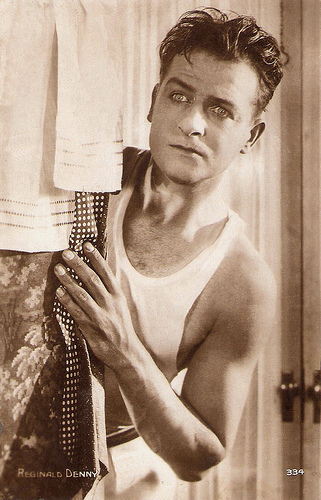
Reginald Denny . French postcard by Cinémagazine-Edition, Paris, no. 334.
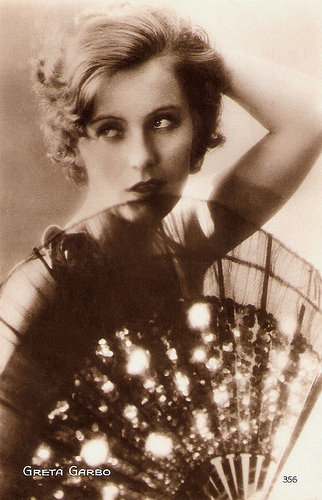
Greta Garbo . French postcard by Cinémagazine-Edition, Paris, no. 356.
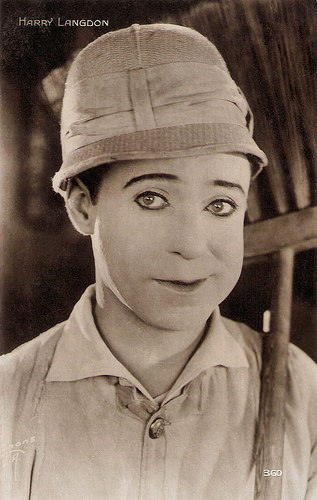
Harry Langdon. French postcard by Cinémagazine-Edition, Paris, no. 360. Photo: ...nons, Los Angeles (?).
Sepia brown tone
Cinémagazine-Edition or CE was the publisher of the film magazine of the same name, that was popular all over Europe. It was a weekly magazine that existed between 1921 and 1935. Among the authors were illustrious future directors like Marcel Carné, Jean Dréville and Robert Florey. Cinémagazine brought an attractive mix of attractive films and star iconography on the one side and more in-depth information, reviews, feature articles, on the other.
Like other publishers of film magazines, CE also produced film memorabilia such as hundreds of film star postcards. Cinémagazine-Edition published film postcards of both Hollywood stars and European stars in a sepia brown tone. At the end of the production the postcards also came in a lighter version and sometimes also the colour differed.
Most of the postcards contain studio portraits, but a few series of postcards have stills from popular films, such as the Hollywood spectacle Ben-Hur: A Tale of the Christ (Fred Niblo, 1925) and the French war drama Verdun, visions d'histoire (Léon Poirier, 1928)
All the Cinémagazine postcards were in a regular postcard format, and there were no other sizes and also no colorized merchandise.
A good identification is the company symbol, printed on each card on the lower left edge (a capital C containing a capital E). The complete name of the card collection was 'CINEMAGAZINE-EDITION, PARIS'. You can read that on the reverse side of each card, together with 'Made in France'.
The different card numbers were also on the front in the left corner. They counted from 1 (Norma Talmadge) to 1099 (Laurel and Hardy) and then from 2000 (David Newell) till 2113 ( Claude Dauphin ). In 1934 followed a 'Nouvelle serie' with a postcard of Marcelle Chantal as no. 1. This series contained about one hundred cards.
Most postcards were in a longish format. Some of the partners postcards were produced in a horizontal format. Most of the later postcards have a white frame around the photos.
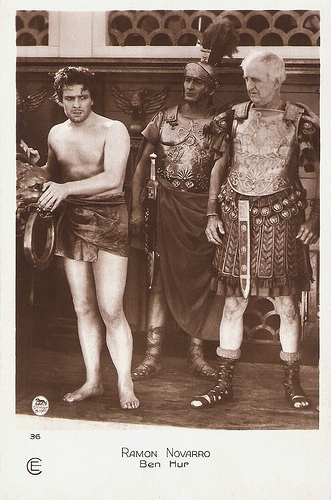
Ramon Novarro in Ben Hur. French postcard by Cinemagazine-Edition, Paris, no. 36. Photo: Metro-Goldwyn-Mayer (MGM). Publicity still for Ben-Hur: A Tale of the Christ (Fred Niblo, 1925).
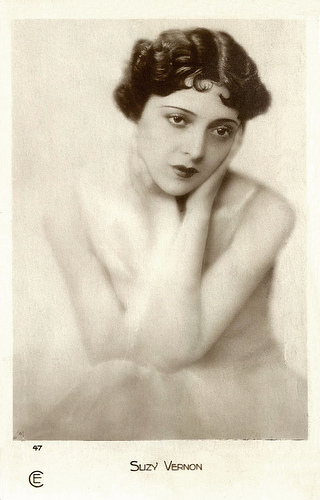
Suzy Vernon . French postcard by Editions Cinémagazine, no. 47.
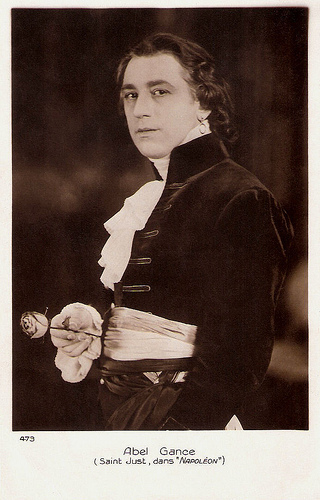
Abel Gance . French postcard by Cinémagazine-Edition, no. 473. Photo: publicity still for Napoléon (Abel Gance, 1927), with Gance himself as Saint Just.
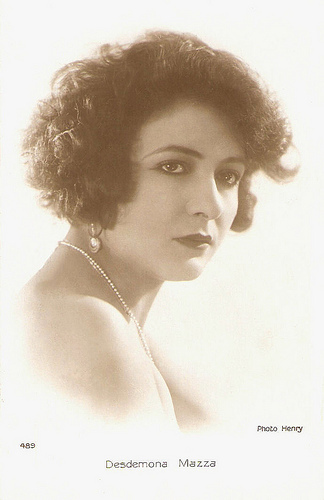
Desdemona Mazza . French postcard by Cinémagazine-Edition, Paris, no. 489. Sent by mail in 1928. Photo: Henry.
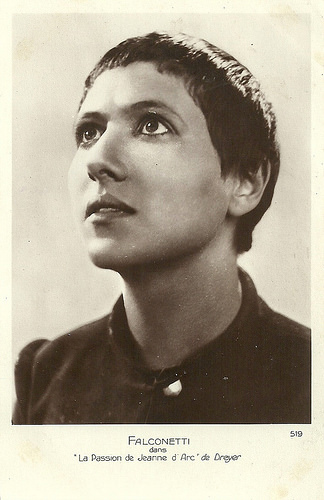
Renée Falconetti in La Passion de Jeanne d'Arc. French postcard by Editions Cinémagazine, no. 519.
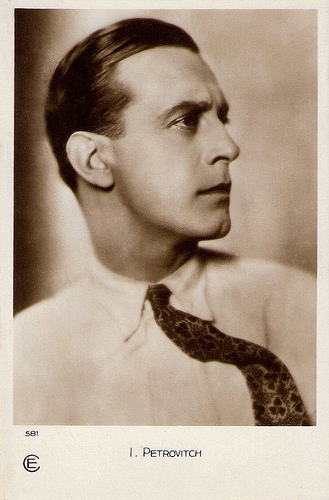
Ivan Petrovich . French postcard by Cinémagazine-Edition, Paris, no. 581.
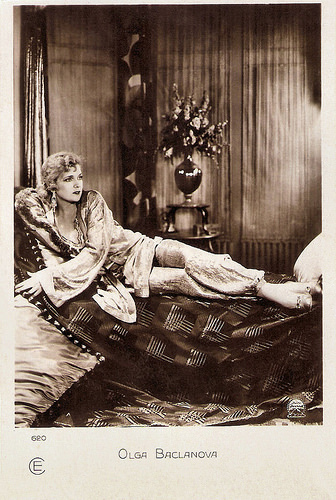
Olga Baclanova . French postcard by Cinémagazine-Edition, Paris, no. 620. Photo: Paramount.
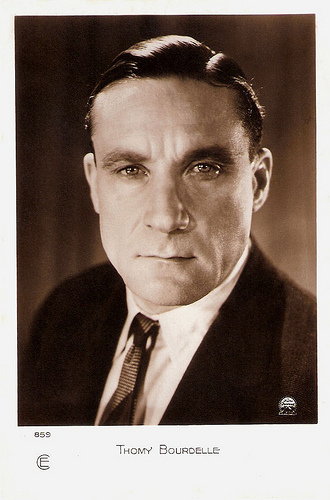
Thomy Bourdelle . French postcard by Cinémagazine-Edition, no. 859. Photo: Paramount.
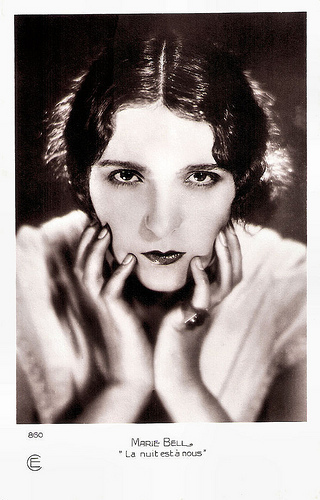
Marie Bell in La nuit est à nous. French postcard by Cinémagazine-Edition, no. 860.
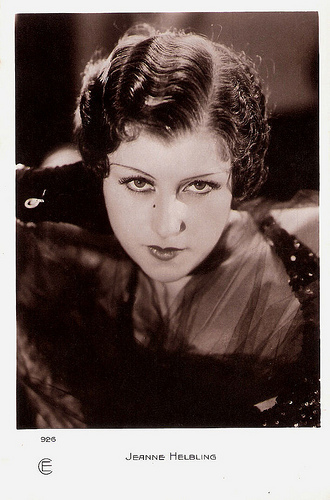
Jeanne Helbling . French postcard by Cinémagazine-Edition (CE), Paris, no. 926.
This was the fourth post in a new series on film star postcard publishers. For earlier posts, see the links at right under the caption 'The Publishers'. Next Wednesday: the Dutch publisher JSA.
Source: Garbo Forever, Gallica and Cinema Players Postal Antiquities.

Rudolph Valentino. French postcard by Cinémagazine-Edition, Paris. Photo: James Abbe.

Betty Balfour. French postcard by Cinémagazine Edition, no. 84. Photo: Maull & Fox.

Régine Dumien . French postcard by Cinémagazine-Edition, no. 130.

Raquel Meller. French postcard by Cinémagazine-Edition, Paris, no. 165. Photo: J. Kruger.

Mistinguett . French postcard by Cinémagazine-Edition, Paris, no. 175. Photo: P. Apers.

Lilian Gish. French postcard by Cinémagazine-Edition, Paris, no. 236.

Maciste. French postcard by Editions Cinémagazine, no. 368. Bartolomeo Pagano aka Maciste in Maciste all'inferno (Guido Brignone, 1926).

Reginald Denny . French postcard by Cinémagazine-Edition, Paris, no. 334.

Greta Garbo . French postcard by Cinémagazine-Edition, Paris, no. 356.

Harry Langdon. French postcard by Cinémagazine-Edition, Paris, no. 360. Photo: ...nons, Los Angeles (?).
Sepia brown tone
Cinémagazine-Edition or CE was the publisher of the film magazine of the same name, that was popular all over Europe. It was a weekly magazine that existed between 1921 and 1935. Among the authors were illustrious future directors like Marcel Carné, Jean Dréville and Robert Florey. Cinémagazine brought an attractive mix of attractive films and star iconography on the one side and more in-depth information, reviews, feature articles, on the other.
Like other publishers of film magazines, CE also produced film memorabilia such as hundreds of film star postcards. Cinémagazine-Edition published film postcards of both Hollywood stars and European stars in a sepia brown tone. At the end of the production the postcards also came in a lighter version and sometimes also the colour differed.
Most of the postcards contain studio portraits, but a few series of postcards have stills from popular films, such as the Hollywood spectacle Ben-Hur: A Tale of the Christ (Fred Niblo, 1925) and the French war drama Verdun, visions d'histoire (Léon Poirier, 1928)
All the Cinémagazine postcards were in a regular postcard format, and there were no other sizes and also no colorized merchandise.
A good identification is the company symbol, printed on each card on the lower left edge (a capital C containing a capital E). The complete name of the card collection was 'CINEMAGAZINE-EDITION, PARIS'. You can read that on the reverse side of each card, together with 'Made in France'.
The different card numbers were also on the front in the left corner. They counted from 1 (Norma Talmadge) to 1099 (Laurel and Hardy) and then from 2000 (David Newell) till 2113 ( Claude Dauphin ). In 1934 followed a 'Nouvelle serie' with a postcard of Marcelle Chantal as no. 1. This series contained about one hundred cards.
Most postcards were in a longish format. Some of the partners postcards were produced in a horizontal format. Most of the later postcards have a white frame around the photos.

Ramon Novarro in Ben Hur. French postcard by Cinemagazine-Edition, Paris, no. 36. Photo: Metro-Goldwyn-Mayer (MGM). Publicity still for Ben-Hur: A Tale of the Christ (Fred Niblo, 1925).

Suzy Vernon . French postcard by Editions Cinémagazine, no. 47.

Abel Gance . French postcard by Cinémagazine-Edition, no. 473. Photo: publicity still for Napoléon (Abel Gance, 1927), with Gance himself as Saint Just.

Desdemona Mazza . French postcard by Cinémagazine-Edition, Paris, no. 489. Sent by mail in 1928. Photo: Henry.

Renée Falconetti in La Passion de Jeanne d'Arc. French postcard by Editions Cinémagazine, no. 519.

Ivan Petrovich . French postcard by Cinémagazine-Edition, Paris, no. 581.

Olga Baclanova . French postcard by Cinémagazine-Edition, Paris, no. 620. Photo: Paramount.

Thomy Bourdelle . French postcard by Cinémagazine-Edition, no. 859. Photo: Paramount.

Marie Bell in La nuit est à nous. French postcard by Cinémagazine-Edition, no. 860.

Jeanne Helbling . French postcard by Cinémagazine-Edition (CE), Paris, no. 926.
This was the fourth post in a new series on film star postcard publishers. For earlier posts, see the links at right under the caption 'The Publishers'. Next Wednesday: the Dutch publisher JSA.
Source: Garbo Forever, Gallica and Cinema Players Postal Antiquities.
Published on April 07, 2015 22:00
Paul van Yperen's Blog
- Paul van Yperen's profile
- 13 followers
Paul van Yperen isn't a Goodreads Author
(yet),
but they
do have a blog,
so here are some recent posts imported from
their feed.



